WHAT'S NEW:
BACKGROUND:
Mission
Project Description
Cruise Plans:
Participants
Technology (ROV, ships, etc.)
Future Plans
Results:
1998 NeMO Cruise
Axial 1998 "Eruption"
Teacher At Sea Logbook
Teacher logbooks:
Thompson Teacher-At-Sea logbook:
June 20, 21, 22, 23, 24, 25, 26, 27, 28, 29, 30, July 1, 2, 3, 4, 5, 6, 7, 8, 9 10, 11, 12, 13July 13
Teachers log #23 7/13/99
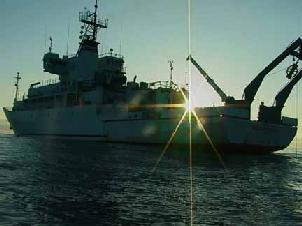 The day
has finally come that we both dread and look forward to. Over the last
few days many have asked if I was ready for the cruise to come to an end.
I definitely have mixed emotions about it. This is likely the case whenever
you immerse yourself in a task that you find intellectually stimulating
and adventurous. Never before had I attempted such a journey; to leave
home and family and join a staff of excellent
scientists and students for a month long investigation of a topic
that I have always thought was fantastic. Fourteen years ago I was introduced
to Steve Hammond
(Program Manager for the NOAA EOI Program) at Hatfield
Marine Science Center in Newport Oregon. His topic was the hydrothermal
venting that was occurring along the
The day
has finally come that we both dread and look forward to. Over the last
few days many have asked if I was ready for the cruise to come to an end.
I definitely have mixed emotions about it. This is likely the case whenever
you immerse yourself in a task that you find intellectually stimulating
and adventurous. Never before had I attempted such a journey; to leave
home and family and join a staff of excellent
scientists and students for a month long investigation of a topic
that I have always thought was fantastic. Fourteen years ago I was introduced
to Steve Hammond
(Program Manager for the NOAA EOI Program) at Hatfield
Marine Science Center in Newport Oregon. His topic was the hydrothermal
venting that was occurring along the 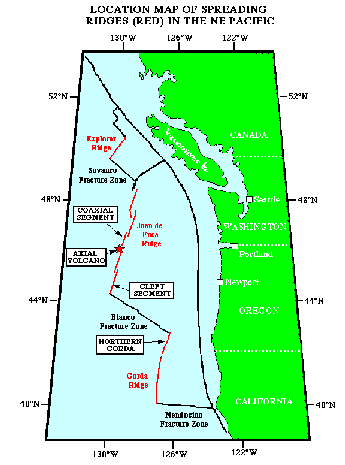 Juan
de Fuca Ridge (map left, click for full size) and Axial Volcano. At the
time, I had no idea these things existed so close. They seemed
to be at some exotic local that I knew I would never come close to visiting.
For the last month, I have had the privilege of observing true science
first hand at a place I never thought possible. The first time that I
stepped into the ROPOS lab and had
opportunity to view the unique and bizarre world of a hydrothermal vent
was fantastic. It certainly beats sitting at home watching a NOVA special
or National Geographic video. I have been able to share with many
members of the science staff my ideas and ask questions. The images I
will return to the classroom with are priceless. To actually see a
fissure in the oceans crust where sea floor spreading is occurring is
so far superior to any text or periodical photo. You can actually
see the heat rising from the crust in the vent fluid. The graceful movements
of animals seem so illogical at the extreme pressure they exist at. To
hear the excitement in peoples voices, both those who are new and those
that are experienced, exclaiming how marvelous what they are witnessing,
can be rather contagious. You get to the point that you don't want the
dive to end. The collegial atmosphere is one that we don't see as often
as we should in any profession. These are just some of the reasons I,
and probably others dread this day.
Juan
de Fuca Ridge (map left, click for full size) and Axial Volcano. At the
time, I had no idea these things existed so close. They seemed
to be at some exotic local that I knew I would never come close to visiting.
For the last month, I have had the privilege of observing true science
first hand at a place I never thought possible. The first time that I
stepped into the ROPOS lab and had
opportunity to view the unique and bizarre world of a hydrothermal vent
was fantastic. It certainly beats sitting at home watching a NOVA special
or National Geographic video. I have been able to share with many
members of the science staff my ideas and ask questions. The images I
will return to the classroom with are priceless. To actually see a
fissure in the oceans crust where sea floor spreading is occurring is
so far superior to any text or periodical photo. You can actually
see the heat rising from the crust in the vent fluid. The graceful movements
of animals seem so illogical at the extreme pressure they exist at. To
hear the excitement in peoples voices, both those who are new and those
that are experienced, exclaiming how marvelous what they are witnessing,
can be rather contagious. You get to the point that you don't want the
dive to end. The collegial atmosphere is one that we don't see as often
as we should in any profession. These are just some of the reasons I,
and probably others dread this day.
As far as why I am looking forward to the end, well what can I say, I've been at sea for a month. Some of the joys of life at sea include sleeping in a cramped cold bunk, eating regularly (not something I do) and forgetting what day of the week it is because weekends do not exist. I've had time to research a fair bit, I've read some good books, and even sat in on some good movies. But it is time to rejoin the real world I live in. I bring back a lot of thoughts and ideas, some bigger than others. I wish to thank my family for allowing me this opportunity to be away from home and take part in an adventure. The families of the other members of this cruise need thanking also. To all those who have made my job a truly enjoyable experience, thank you. This has been the best classroom learning experience I have had the pleasure to be in. As the NeMO 1999 cruise ends, thanks to all those who logged on to see how we were doing out here.
July 12
Teachers Log #22 7/12/99
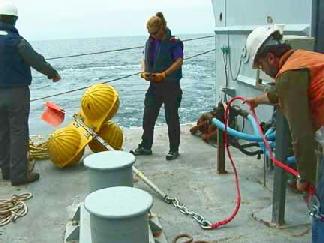 Between dives
yesterday, Jim Gendron supervised
the deployment of moorings (photo right) for Ed
Baker (the principle investigator on this project) of NOAA/PMEL in
Seattle. These moorings and the sensing equipment on them are another
way to monitor eruptive events by looking at the plumes that are associated
with them. These instruments are used around the world at many volcanically
active sites. They can be deployed for long-term use as they are doing
here at Axial, or they can be towed through selected areas for temporary
data collection.
Between dives
yesterday, Jim Gendron supervised
the deployment of moorings (photo right) for Ed
Baker (the principle investigator on this project) of NOAA/PMEL in
Seattle. These moorings and the sensing equipment on them are another
way to monitor eruptive events by looking at the plumes that are associated
with them. These instruments are used around the world at many volcanically
active sites. They can be deployed for long-term use as they are doing
here at Axial, or they can be towed through selected areas for temporary
data collection.
Hydrothermal vent plumes are fluids that are released from vents, rise in the water column and begin mixing with the surrounding sea water. The rising fluid is referred to as the buoyant plume whereas the fluid that spreads out once it reaches a specific height in the water column is the non-buoyant plume. Plumes can be studied by looking at the "signature" of the plume - the temperature, metals, and other unique elements of the plume change with the distance it travels from the actual vent site. Some elements like helium (He) can leave a "trail" in the water column not only as it rises but also as it spreads out once it becomes non-buoyant. Megaplumes are rare events. These are extremely large short-lived events, expelling incredible volumes of fluid that are associated with eruptions like that of 1998. The thermochemical signature of this type of plume can be mapped for many miles through the ocean. Just what the impact is of these megaplume events on the oceans overall thermochemical budget is just one of the many questions being investigated.
The set up for the deployment of these moorings includes an anchor and floatation at opposite ends. Between them, the data collecting sensors and a release mechanism are positioned. Just above the anchor sits an acoustic release. These make it possible for a ship-based retrieval instead of depending on an ROV to cut them loose. Along the 300 meters of line are temperature and nephelometer recorders. The placement of these instruments is based on scientific prediction as to where in the water column hydrothermal non-buoyant plumes will be. The temperature probes are designed to record the water temperature at a specific time interval each day for a year. Also included are combinations of a temperature and pressure sensor along with a nephelometer. The nephelometer sends out a beam of light into the water. The amount of reflected light that it receives back enables scientists to determine how much particulate matter is in the water from the hydrothermal vents. At the beginning of our cruise, the Wecoma, another ship out of Oregon State University, was on site deploying similar moorings around the outer perimeter of Axial.
This morning we completed our first dive of this cruise at Ashes vent field. This was a remarkable site with one vent having 310 degree Celsius fluid pouring out of it! By observing the rapid nature of its escape from the vent as well as shimmering nature, one could almost "see" the heat it contained. Currently we are back down at Ashes for our last dive of the cruise!
Bye for now.
July 11
Teachers Log #20 7/11/99
While observing the scientists prepare for a dive I noticed that all containers for sampling vent fluids and organisms were first filled with seawater. The reason this is done is to prevent the containers from being crushed by the pressure of the water as the ROV makes its way to the bottom. In fact, I'm told that if there is any air within the containers as they descend, that at about 15 meters below the surface they would implode and be crushed. Why does this happen?
When I stand out on deck, the air above me is pushing down with a force equal to one atmosphere of pressure. I don't even notice it. In fact, we all take it for granted. Imagine that I jump in (boy this water is cold) and swim downward, I feel the pressure in my ears. The rest of my body does not register this small amount of pressure increase. If I went deeper, say 1500 m down, any part of my body that contained air would collapse and be flattened. Not a pleasant thought. As you increase the depth of your dive, the pressure is a cumulative factor. For each 10 m (32 feet), you add one more atmosphere (atm). At 1500 m, where we are diving, the pressure is roughly 150 atm or just over 2200 lb. per square inch. This is one reason we use ROPOS to do our bidding at the bottom. Even it sometimes suffers from the extreme pressure below. All of the equipment on ROPOS has to be specially designed to operate in this high pressure environment.
 There has been
an increased level of artistic creativity around the ship. Styrofoam cups
and wig heads are becoming major art projects. Late in most cruises, students
mostly, but also some of the more grizzled veterans of the sea, go about
creating souvenirs for themselves and loved ones back home. After designing
and coloring the cups and wig heads, they are bagged and strapped to the
ROVs cage. When they come back to the surface, they are very small because
as they drop through the water column, increasing pressure forces out
the air trapped within the foam. Some, come up shriveled and misshapen
while others look like perfect miniatures. They make for great conversation
pieces.
There has been
an increased level of artistic creativity around the ship. Styrofoam cups
and wig heads are becoming major art projects. Late in most cruises, students
mostly, but also some of the more grizzled veterans of the sea, go about
creating souvenirs for themselves and loved ones back home. After designing
and coloring the cups and wig heads, they are bagged and strapped to the
ROVs cage. When they come back to the surface, they are very small because
as they drop through the water column, increasing pressure forces out
the air trapped within the foam. Some, come up shriveled and misshapen
while others look like perfect miniatures. They make for great conversation
pieces.
Bye for now.
July 10
Teacher Log #19 7/10/99
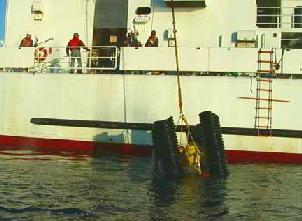 The elevator, positively buoyant in the water without its weights. |
When an object is placed in water, there are two forces acting upon it. One force (gravity) pushes down while the other (buoyancy) pushes up. Which ever force is greatest determines whether floating or sinking occurs. The balance between the two forces can depend on the volume, shape and weight of the object. Buoyancy is related to the weight of the water displaced by the object being submerged. When an object's weight is less then that of the water it displaces, it is said to be positively buoyant. It then floats, as our elevator and transponders do. When the opposite occurs, sinking takes place. So, what does this have to do with what's going on out here?
Each time ROPOS is prepared for a dive, the weight of the ROV and all equipment used must be determined so that ROPOS can remain positively buoyant. Anytime a new piece of equipment is used, it is hooked to spring scale and lowered into the water to determine what it weighs in water. Adjustments are then made on ROPOS. Lead weights attached to the ROVs sled pads are removed or added depending on the payload. It is also important to maintain ROPOS's trim or balance while in the water. Too much weight one side or the other, and it will be tilted. One of our dives this month was ended early for this reason. When under water, a careful eye is kept on the cumulative weight of the fluid, geological and biological samples that are being collected. Positive buoyancy of the ROV is important if for some reason it were to become disconnected from the cage, due to its positive buoyancy, it would slowly float back to the surface where a recovery could be made. This happened back in October of 1996, when during a storm, ROPOS's tether snapped. It was spotted at the surface but due to the tenacity of the storm, was never recovered. When ROPOS is at the bottom, thrusters are needed to keep it down just as a swimmer must keep using energy to stay below the surface. The cage that ROPOS is housed in is negatively buoyant. It sinks when placed in the water. In fact, its negative buoyancy is used to help pull the cable that is unwound by the winch. Scuba divers try to stay neutrally buoyant and use buoyancy compensators to develop a balance between the upward and downward forces. This allows a diver to maintain a desired depth, thus saving the energy normally exerted for staying down.
So you can see how controlling the buoyancy of oceanographic equipment is very important. You need to get your instruments to sink to the bottom, but you also want to be able to get them back again. For tomorrow, think about how modern ships which are made of metal (far more dense then water) are made so as to create positive buoyancy. We'll talk tomorrow about the mysterious shrinking heads.
Bye for now.
July 9
Teacher Log #19 7/9/99
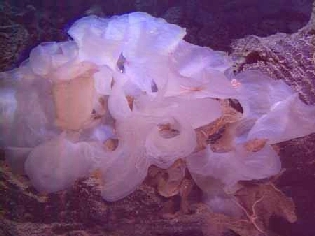 Animal seen at CASM vent; most likely a sponge. |
The organisms that are most common to all vent sites are the various forms of microbes, bacteria and archaea. Fluid samples of the vents and suction samples of the surface show an abundance of these microorganisms. The macrofauna (larger animals) are the most visible of the hydrothermal vent ecosystems. Each vent with its own peculiar chemical signature and temperature, creates an environment for specific creatures. Any vent site may have any number of smaller communities each with its own diversity of organisms.
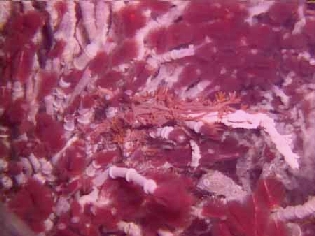 Palm worms overlaying tube worms; palm worms behave agressively towards each other. |
Carnivorous species also exist here but are found in smaller numbers. Within the tube worm bushes, crawling about on open surfaces and even swimming, scale worms, centipede like creature with scales on their backs can be found in large numbers (some species are grazers as well). Nereid worms are not as commonly seen, but make up an important link in the transference of nutrient energy. Crabs and octopi can also be seen here searching for a meal, as can vent fish and the ever common rattail fish.
The most unique of the organisms at hydrothermal vents are the tube worms. These creatures, which have no mouth or anus, are known to have large numbers of bacteria within their tissues. This unique relationship (symbiosis) is believed to benefit both organisms - bacteria get a suitable environment to live and the worm takes advantage of the chemosynthetic properties of the bacteria for it nutrients. The most noticeable part of the tube worms are the bright red gill plumes that extend from the tops of their tubes. This gill plume is believed to absorb the vent fluid, which is then spread throughout the body of the organism, thereby feeding the bacteria.
The end of our cruise is quickly approaching. ROPOS is on the way to the bottom for its 500th dive! Will update you on its results tomorrow.
Bye for now.
July 8
Teachers Log #18 7/8/99
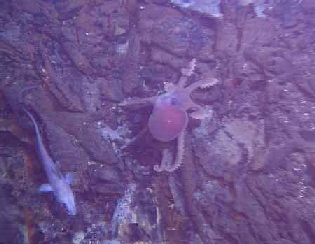 Octopus and rattail fish at the CASM vent site. |
When hydrothermal vents were first discovered in the late 70s near the Galapagos Islands, the deep ocean floor was believed to be desert-like. We now know that there is a wide diversity of life in these areas and have gained a better understanding of the interactions between the geology, chemistry and biology in deepsea environemnts, including hydrothermal vents.
Life at the vent site is intimately connected to the vent fluid. (see
diagram below) As
seawater seeps through the porous crust of the seafloor, it is heated and
reacts with the chemicals in the rock. The heat is believed to come from a
magma chamber within the ocean crust. This superheated water rises rapidly
through the crust, seeking a way to the surface. This is what we refer to
as hydrothermal vent fluid.

Most of the
microbes (bacteria and archea)
that exist here are referred to as hyperthermophiles because they exist in
an environment that is above 80 degrees Celsius (about 180 degrees
Farenheit) and probably anoxic (without oxygen). Factors such as space,
nutrients and temperature are important limiting factors of this area, but
have yet to be specifically determined. Within the vents and under the
seafloor surface, it is possible that subsurface microenvironments exist.
How many, what kind and how deep they go is still a mystery. As with all
vent microbes, they rely on chemosynthesis as
their source of energy rather than photosynthesis (remember, no sunlight -
no photosynthesis). (Chemosynthesis uses the oxidation of sulphide from
the vents rather than sunlight to create energy.) It is unknown just what
role the subsurface plays in the development of the surface ecosystem.
Many believe there is a definite connection. But we do know that the
microbes are the basis for the food web in this mysterious ecosystem.
Tomorrow we'll finish this discussion on the hydrothermal vent ecosystem
with special attention on the macrofauna (multicellular animals).
Bye for now.
July 7
Teachers log #17 7/7/99 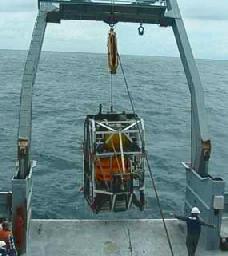 What a morning!
Under gray skies and calm seas, ROPOS successfully cut the anchor tether
line holding the recently released rumbleometer
from its 20 month stay on the seafloor. While it slowly floated to the
surface, ROPOS was brought aboard (photo left). The small recovery boat
successfully collected the rumbleometer and towed it to the Thompson.
After it was secured on deck it was examined and we noticed that small
areas of melting were visible on the yellow plastic floats and some
had lava fragments embedded in them. Chief
Scientist Bob Embley and staff began removing the instrumentation
following their inspection. The seismic data collected will be fully analyzed
back on shore. Dive 496 included some biological sampling and Imagenex
surveying in addition to the rumbleometer recovery and was a huge
success.
What a morning!
Under gray skies and calm seas, ROPOS successfully cut the anchor tether
line holding the recently released rumbleometer
from its 20 month stay on the seafloor. While it slowly floated to the
surface, ROPOS was brought aboard (photo left). The small recovery boat
successfully collected the rumbleometer and towed it to the Thompson.
After it was secured on deck it was examined and we noticed that small
areas of melting were visible on the yellow plastic floats and some
had lava fragments embedded in them. Chief
Scientist Bob Embley and staff began removing the instrumentation
following their inspection. The seismic data collected will be fully analyzed
back on shore. Dive 496 included some biological sampling and Imagenex
surveying in addition to the rumbleometer recovery and was a huge
success.
ROPOS is being prepared for another complicated dive along the North Rift Zone and a vent called CASM. Dr. Bill Chadwick is planning to deploy one new extensometer (photo right) and retrieve four that were left at this site last year.
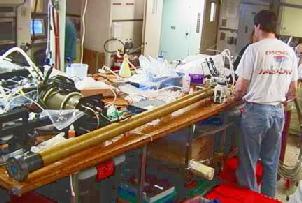 Bill Chadwick preparing the extensometer's electronics for deployment. |
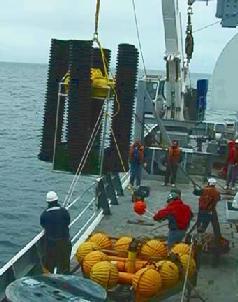 The extensometer inside the elevator preparing for deployment |
Remember that when using the elevator we need to have calm seas and good weather, so keep your fingers crossed. Dive 497 is on its way to the bottom now to deal with the extensometers. Stay tuned for an update tomorrow.
Bye for now.
July 6
Teachers Log #16 7/6/99
As soon as ROPOS was settled and secured to the deck last night the excitement began. For many it was a long night in the lab sample recording, analyzing, and data processing. This morning ROPOS was ready to begin its new mission, recovery of the Rumbleometer.
In October of 1997, two instrument packages called Rumbleometers were deployed to provide a continuous daily recording of the activity within the Axial Caldera and along the South Rift Zone. Each Rumbleometer was comprised of five sensing and recording instruments, each specifically designed to detect and record changes in this active region. Pressure gauges would pick up any changes in the depth of the sea floor by recording either increases or decreases in pressure. Seismic sensors were tuned for sensing the harmonic tremors that accompany volcanic eruptions. Current meters used for measuring the movement of the water around the instrument and, temperature recorders were also included. A tiltmeter would hopefully provide information about any faulting or shifting that took place.
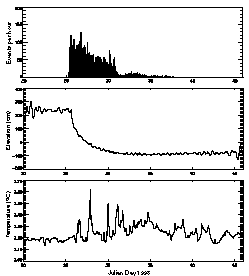 Data from 1998 recovered VSM showing the 3 meters of downdrop associated with the eruption. |
Next year is here, and today is the day. In an operation that requires a surface recovery, daylight and calm seas are important. With weather again cooperating, ROPOS went about hooking the Rumbleometer in a different manner than was tried in the previous year. This year a 10,000 lb. weak link is being used (a 2000 lb link was used last year) and instead of hooking to the top of the unit, the one exposed leg is the target. After some trick maneuvering by the ROV and the two manipulator
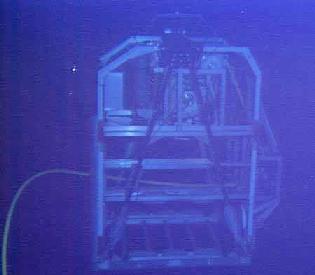 ROPOS's cage used to pull at the Rumbleometer, setting it free after 20 months on the seafloor. |
Bye for now.
July 5
Teacher Log #15 7/5/99
Its turning out to be a great day on the Pacific. When my alarm went off this morning the first thing I noticed was an absence of movement. I stepped out onto the weather deck and saw that the water was calmer than any day weve had so far. The wind was blowing under 5 knots and the sky was cloudy with a few patches of blue to allow some morning light to color the ocean surface. Often we are all so busy out here that we don't get out on deck to observe the day, especially when ROPOS is in the water. Dive 495 is still in progress after over 15 hours. The hot fluid sampler is working great and the sea purse, attached for rock collecting, is already full.
The last few days I've talked about the ROPOS lab, indicating it as "the place
to be." When a dive is in progress it takes a minimum of seven people
to perform all of the functions, but there may be as many as 15
people crowding around to watch the action. 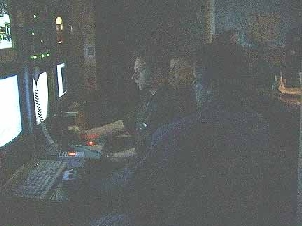 Sitting up in front of the room in the pilot's chair can be any one of
the ROPOS technicians (photo right). Some fly the ROV more than others,
but each one does have the opportunity. Sitting to the right of the pilot
is the co-pilot/navigator/arm manipulator. This person is the one who
so delicately positions instruments and samplers. Viewing a two dimensional
video screen, he must somehow find the right range and depth needed to
complete specialized tasks using the seven function arm. The third technician
is in and out of the room doing the odd jobs necessary that go unnoticed
by the preoccupied scientists and viewers. Fixing a computer at one station,
reconnecting a video line, checking the angle of the cable or fixing a
broken instrument for future dives are just a few of the chores needing
his attention. The ROPOS crew works
in 12-hour shifts 12 hours on and 12 hours off.
Sitting up in front of the room in the pilot's chair can be any one of
the ROPOS technicians (photo right). Some fly the ROV more than others,
but each one does have the opportunity. Sitting to the right of the pilot
is the co-pilot/navigator/arm manipulator. This person is the one who
so delicately positions instruments and samplers. Viewing a two dimensional
video screen, he must somehow find the right range and depth needed to
complete specialized tasks using the seven function arm. The third technician
is in and out of the room doing the odd jobs necessary that go unnoticed
by the preoccupied scientists and viewers. Fixing a computer at one station,
reconnecting a video line, checking the angle of the cable or fixing a
broken instrument for future dives are just a few of the chores needing
his attention. The ROPOS crew works
in 12-hour shifts 12 hours on and 12 hours off.
Sitting to the left of the pilot is one of the lead scientists selected for the dive. Chosen for his or her knowledge of the specific task at hand, the principal investigator (PI) will direct the pilot as to what goals need to be completed. Besides directing what samples and/or equipment to use, the PI also may take pictures of the site under investigation. The Silicon Intensified Target camera (SIT) takes excellent images of where we are and what is going on. In the second row, positioned around the large workstation in the center of the lab, are the frame grabber, data logger, and the navigators. One of my duties is as a frame grabber. Digital images can be selected from the video display and stored and logged in the computer for future reference. All of the underwater images youve seen of the ocean floor were acquired in this manner. Next to the frame grabber sits the data logger. The data logger is responsible for making note of all that is happening during the dive. On the other side of the data logger is the navigator. The navigator is responsible for knowing the location of ROPOS, the cage, and the ship in relation to the vent site and its real position in the world. And last but not least, sitting in the back corner is the videotape manager. This may sound like one of the easier jobs, but there is a stack of six tape machines and several are turned on and off during the highlights of the dive. Each of these positions is equally as important and are being performed in four hour shifts, around the clock.
Along with all of the required positions, the room is also filled
with scientists watching the action on one of the six video monitors
around the room. The lab gets quite crowded and noisy sometimes but nobody
seems to mind. It is a productive scientific atmosphere where people from
different backgrounds offer their perspective in discussions about the
significance of what they are seeing. A successful dive brightens the
spirits, gets everyones energies going, and adds to the good feeling that
an important job is being done.
Bye for now.
July 4
Teacher Log #14 7/4/99
Happy Fourth of July!
ROPOS dive 494 was a 14-hour success. Most of that time was spent surveying the southern extent of the lava flow from 1998. Once again, the ROPOS lab filled to near capacity as we viewed a fissure (crack) in the ocean floor. (see Science report) Within the fissure there were new lava flows. This new lava flow within the fissure comes from long thin magma bodies called dikes. The injection of these dikes into the crust is part of the process of seafloor spreading. As ROPOS continued to chart this feature, it came upon a region which scientists believe was a major source of the eruption. A large region of new lava seemed to spread out from the axis of the fissure. I've been teaching the ideas of sea floor spreading and continental drift for 19 years now, but the basis for my knowledge has always come from books, lectures and video accounts. To see an actual example of this is spectacular. I'm coming to the realization that geology is more exciting than simply looking at rocks!
While touring the lava flows I've come to understand what is meant by statements like "the ocean floor is a desert" and "hydrothermal vents are the oases of the ocean floor." When you come across an active vent site, you are amazed at the abundance of life. You ask yourself "What creates this"? Throughout the area, some more then others, you can see shimmering water flowing up from below. This is the "fountain of life" for these organisms. When the vent fluid no longer flows, the energy source and nutrient base for this unusual ecosystem ends. One of the factors which determines success of a specific organism or species in the hydrothermal vent ecosystem is being able to compete for the limited living space within and around the flow of fluid.
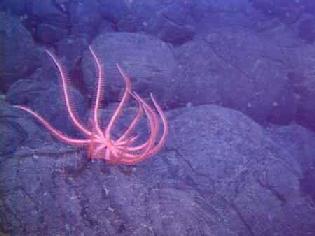 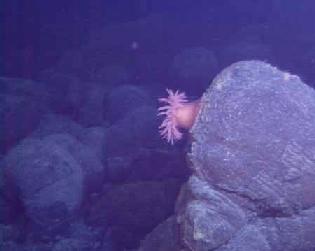 Sea animals outside the influence of the hydrothermal vents (benthic organisms). Top photo is a crinoid and bottom is a sea anemone, both filter feeders. (photos Dive 492-494) |
Bye for now.
July 3
Teacher Log #13 7/13/99
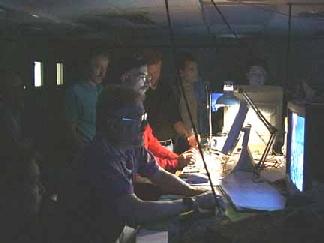 Scientists viewing dive progress and collaborating during dive 493 in the main ROPOS control laboratory. |
You'll find on this cruise a number of scientists, technicians and crew that have spent time on cruises where a manned submersible was used. Three of the ROPOS technicians have actually piloted them in the past (they'll say they flew them). For a time, this was the main tool used for getting information about the seafloor. One disadvantage of this type of submersible is limited space - they can carry a maximum of 3 people, 1 or 2 pilots and no more then 2 scientists. But what it loses in space it gains in its view of the ocean floor. The pilot of course has the best view in the house, but still, many will say that the view through a window beats the view on a monitor screen. You gain the advantage of three dimensional viewing that you just cant see in a monitor. This also aids in more efficient sampling. One disadvantage of a manned submersible is a decrease in bottom time due to a finite supply of oxygen.
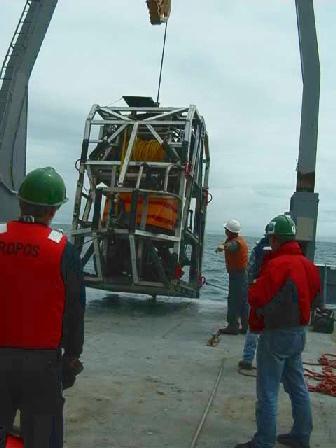 Remotely operated vehicles (ROV's) have been
on the rise for research on the ocean floor since the late 80s. There
are now over 500 working class (ocean going) ROVs in the world today,
supported by numerous countries and special interest groups. The first
one used out on the Juan de Fuca ridge was "Jason"
in 1991. The original ROPOS first explored
these waters in 1992 before it was lost is a storm in October of 1996.
The ROPOS we are now using is a veteran of many research dives all around
the world. What makes ROVs so valuable is their increased potential
bottom time. An ROV can actually spend an infinite amount of time
flying in the oceans depths. The length of the dive is primarily limited
by the number of samples it can carry, so in the case of seafloor mapping,
ROVs have the advantage of being able to run for an unlimited time period.
Once in the water, they are tireless work horses, and have a quicker turn
around time than a manned submersible (as ROPOS proved on the NeMO
cruise last summer with over 250 hours at the bottom in one month!).
When asked, scientists feel that the greatest appeal of an ROV is that
when it is on the sea floor, scientists from all fields can see the action
in real time on video screens (photo above left) and interact and discuss
the observations as well as give directions to the pilot. Discoveries
like we saw yesterday in the new lava flows, can be discussed while the
ROV is poised for direction. Sampling procedures can be debated and directions
can be given. That is science in action!
Remotely operated vehicles (ROV's) have been
on the rise for research on the ocean floor since the late 80s. There
are now over 500 working class (ocean going) ROVs in the world today,
supported by numerous countries and special interest groups. The first
one used out on the Juan de Fuca ridge was "Jason"
in 1991. The original ROPOS first explored
these waters in 1992 before it was lost is a storm in October of 1996.
The ROPOS we are now using is a veteran of many research dives all around
the world. What makes ROVs so valuable is their increased potential
bottom time. An ROV can actually spend an infinite amount of time
flying in the oceans depths. The length of the dive is primarily limited
by the number of samples it can carry, so in the case of seafloor mapping,
ROVs have the advantage of being able to run for an unlimited time period.
Once in the water, they are tireless work horses, and have a quicker turn
around time than a manned submersible (as ROPOS proved on the NeMO
cruise last summer with over 250 hours at the bottom in one month!).
When asked, scientists feel that the greatest appeal of an ROV is that
when it is on the sea floor, scientists from all fields can see the action
in real time on video screens (photo above left) and interact and discuss
the observations as well as give directions to the pilot. Discoveries
like we saw yesterday in the new lava flows, can be discussed while the
ROV is poised for direction. Sampling procedures can be debated and directions
can be given. That is science in action!
The next generation of underwater research vehicles is the Autonomous ROV. These untethered battery operated vehicles would replace the need to be on station in the ocean giving command from above. Imagine sitting in your lab back on land giving directions about what data you want collected. The technology is still a ways off, but the plans are in the works.
Bye for now.
July 2
Teacher Log #12 7/2/99
Today was definitely a day of discovery. Dive 492 was very successful for those interested in hydrothemal vents and their ecosystems. Three new vent sites were located as ROPOS traversed a southern area not yet covered in previous visits. The major goal for this dive was to determine the southern extent of the lava flow from the 1998 eruption. During the cruise in August of 1998, much of the northern portion of the lava flow had been identified. Today ROPOS explored Axials southern rift zone area believed to include part of the 1998 lava flow.
ROPOS was directed to the surface after about a 12 hour dive. The weather and seas were relatively calm so an evaluation was made as to whether we would retrieve the elevator.
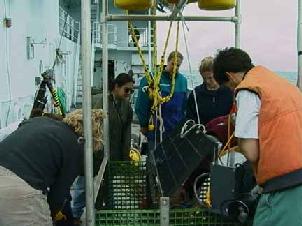 Scientists
removing the samples on deck from elevator which had been deposited
into the elevator on the seafloor. Scientists
removing the samples on deck from elevator which had been deposited
into the elevator on the seafloor. |
One of the true mysteries of the Juan de Fuca vent systems is the presence of spherical blobs of a mucus like substance found at low temperature diffuse flow vent sites. These "creatures" have been found to be associated with vent sites influenced by recent eruptions, including the eruption here at Axial in 1998. Bag creatures as they are affectionately referred as, are muco-polysaccharide blobs filled with water that to this day still have scientists scratching their heads. They are not a living substance. They do not have a cellular makeup. They are most likely a microbial bi-product, but so far, we do not know who is making this substance. Research is being done to determine more about this common but unusual vent substance, but for now its one of lifes little mysteries.
Bye for now
July 1
Teacher Log #11 7/1/99
Happy Canada Day!!
What a marathon! After 38 hours of excellent work at the seafloor, ROPOS was finally directed back in its cage and was hoisted back on deck. Once it was secured, scientists scurried about recovering the samples that were collected. Samples were distributed appropriately and everyone went about the business of cataloging and fixing organisms, filtering water samples and running the various tests. After a successful dive there is always a good feeling among the members of the science and ROPOS staff, and today was one of those days.
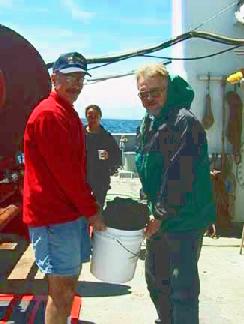 Mike Perfit and Bob Embley carrying a basalt rock sample collected on ROPOS dive 491. |
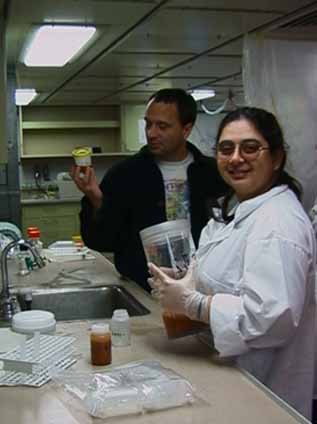 One of the scientists
who collected samples from todays dive is Naaznin Pastakia (photo right)
who is a Masters student from the University
of Toronto. She used the suction
sampler to collect samples of Iron oxyhydroxide produced by microbes
and found on the lava flow. She is interested in specific vents where
this substance is produced. It is her hope to relate this to the iron
and silica rich boundaries seen around pillows in ancient lava flows on
land and prove that they have the same microbial origin.
One of the scientists
who collected samples from todays dive is Naaznin Pastakia (photo right)
who is a Masters student from the University
of Toronto. She used the suction
sampler to collect samples of Iron oxyhydroxide produced by microbes
and found on the lava flow. She is interested in specific vents where
this substance is produced. It is her hope to relate this to the iron
and silica rich boundaries seen around pillows in ancient lava flows on
land and prove that they have the same microbial origin.
After a great day at sea with, the weather is taking a turn for
the worse. The elevator retrieval mission was again postponed due to high
winds and increased seas. It is hoped well be able to get back in the next
day or two.
Bye for now.
June 30
Teacher Log #10 6/30/99
With the sunshine peaking through the clouds and a good breeze (18-22 knots) blowing through the air, the spirits aboard the Thompson are soaring. ROPOS is in the middle of one of the most complicated dives planned for it. It is amazing the things it can be used for and how we have come to depend on it. It has visited over 8 vent sites within the last 24 hours and carried out each of its tasks with little trouble. The "Magnificent 7" of the ROPOS crew have got it humming happily along the bottom.
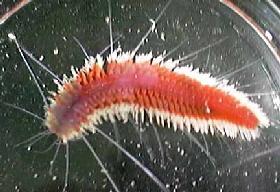 A new species of scaleworm under the microscope aboard the Thompson. (collected 1999, ROPOS). |
Another of ROPOSs tasks today is collecting high resolution bathymetry over the 1998 lava flow, extending the survey made last year. The ROV is "flown" about 10 m above the bottom while a pencil-beam sonar sweeps from side to side measuring the distance to the sea floor. Holding a steady course, ROPOS drives down a number of parallel lines (sort of like mowing a lawn). The resolution is excellent, less than 1 m of the actual sea floor topography. Measuring the depth (bathymetry) using this method is far more accurate then doing so from a ship at the surface. Mapping this area accurately is just another in the many ways scientist hope to understand what geological processes have occurred here. It also allows scientists to set a new baseline from which future changes can be measured.
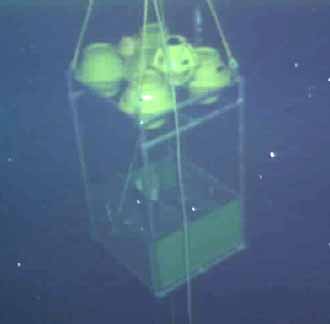 At the present time,
ROPOS is into its 24th hour of diving and is scheduled to continue through
the night. The limiting factor for the dive is usually the number of samples
that can be collected. Once all of the sample containers are full, its
time to head back to the surface, collect the samples and prepare for
the next dive. One way of recovering larger instruments and samples is
by using the "elevator".(photo right) The elevator is basically a big
metal basket that can be used to hold equipment and samples and can be
released from the bottom and retrieved at the surface. Once at the surface
a smaller boat is sent out to retrieve the elevator. Right now, the elevator
is loaded with last years recovered equipment and biological
samples, and scientists are anxious to get it back. The plan was to
retrieve the elevator tonight, but the seas were a little too choppy and
this creates the risk of losing the precious cargo inside, so it was decided
to wait until morning and hope for calmer seas.
At the present time,
ROPOS is into its 24th hour of diving and is scheduled to continue through
the night. The limiting factor for the dive is usually the number of samples
that can be collected. Once all of the sample containers are full, its
time to head back to the surface, collect the samples and prepare for
the next dive. One way of recovering larger instruments and samples is
by using the "elevator".(photo right) The elevator is basically a big
metal basket that can be used to hold equipment and samples and can be
released from the bottom and retrieved at the surface. Once at the surface
a smaller boat is sent out to retrieve the elevator. Right now, the elevator
is loaded with last years recovered equipment and biological
samples, and scientists are anxious to get it back. The plan was to
retrieve the elevator tonight, but the seas were a little too choppy and
this creates the risk of losing the precious cargo inside, so it was decided
to wait until morning and hope for calmer seas.
So, hope for good weather and wish us luck.
Bye for now.
June 29
Teacher Log #9 6/29/99
With calmer seas and high expectations of a day diving to the sea floor, we began our tenth day at sea. ROPOS is now in the water for it second time today. During the first attempt toady, it was back on deck within an hour due to difficulties with the color video camera necessary for viewing the bottom. During the day I had the opportunity to visit with David Butterfield about one of the more important pieces of equipment, the Hot Fluid Sampler.
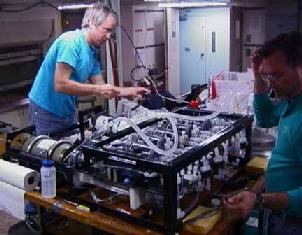 Dave Butterfield making adjustments to the HFS. |
With a researcher at the controls, the probe is placed within the specific vent location. As a sample of vent fluid is drawn through the main sample line by the flushing pump, the temperature of the incoming fluid is determined. It continues through the pipeline of the system until it comes to a junction. At this time it is again measured for temperature. This second temperature reading is important to determine if the sample being taken is most vent fluid or a mixture of sea water and vent fluid. The smaller the difference in temperature the higher the probability it is a good quality vent fluid sample. Temperature can also be important in dealing with extremely hot vent fluids. If the sample is too hot, the collecting jars can melt. When it is determined that the incoming fluid is probably a high quality sample, the command is given via a computer signal to collect it. The incoming sample can be either collected into one of six piston samplers, diverted to one of eight collecting bags, or sent to one of ten independent filters. After the sample has been collected, It can also be determined just how much fluid was collected. The sampling pump is then turned off . This flushing pump helps to keep the lines clear of debris as well as to help keep one sample from contaminating another. Congratulations to Dave and all those who helped in taking this idea and turning it into a reality.
Good news for all aboard, ROPOS has reached the bottom and will
hopefully have a good dive. Highlights tomorrow as well as a visit around
the ship. Stay Tuned.
Bye for now.
June 28
Teacher at Sea Log #8 6/28/99It was a far different day today then we had yesterday. Even ROPOS is taking the day off. Technicians are working diligently to get rid of the glitch (hydraulic problem) that has continued to cause us frustration. So with our trusty ROV on the deck and the boat tossing and turning due to heavier winds (15 - 20 knots) and seas (5 - 10 ft swells), the goals for today are transponder calibration and some biological lab work.
As I mentioned in an earlier report, while ROPOS is in the water, it
is important to know where it is in relation to the vent site, ship and
its cage. In order to accomplish this, the dive site needs preparing.
This is accomplished using transponders. On vent sites that are visited
most 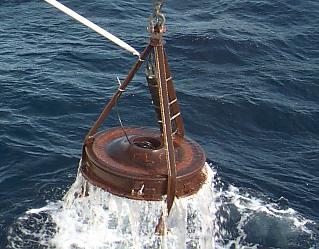 often, more permanent transponders are placed that can stay deployed for
about 5 years. For those sites visited less often, temporary transponders
are deployed. They will be recovered after that site has been studied.
In order to trust the data gathered from the transponders, calibrations
need to be made and that takes time. To do this, our navigation specialists,
Bill Chadwick along
with Susan Merle,
Paul Johnson and Maia Tsurumi, lower a rather odd looking instrument over the side. "El
Guapo" (which means the handsome one), is a train wheel with a communication
device attached to it. (photo right) With this device suspended some 35
m below the ship, sound signals radiate out from it at a specific frequency.
When that sound reaches the transponders, that frequency triggers a response
and the transponders send signals back. Based on the frequency and time
it takes for the reply, the computer on board is able to get a better
location set for each one. The ship moves about the area where the transponders
have been dropped, collecting the data points needed for an accurate fix
for all transponders placed. The locations they were dropped in could
be used for their fixed positions but they are inaccurate. Any given GPS
(latitude and longitude)
often, more permanent transponders are placed that can stay deployed for
about 5 years. For those sites visited less often, temporary transponders
are deployed. They will be recovered after that site has been studied.
In order to trust the data gathered from the transponders, calibrations
need to be made and that takes time. To do this, our navigation specialists,
Bill Chadwick along
with Susan Merle,
Paul Johnson and Maia Tsurumi, lower a rather odd looking instrument over the side. "El
Guapo" (which means the handsome one), is a train wheel with a communication
device attached to it. (photo right) With this device suspended some 35
m below the ship, sound signals radiate out from it at a specific frequency.
When that sound reaches the transponders, that frequency triggers a response
and the transponders send signals back. Based on the frequency and time
it takes for the reply, the computer on board is able to get a better
location set for each one. The ship moves about the area where the transponders
have been dropped, collecting the data points needed for an accurate fix
for all transponders placed. The locations they were dropped in could
be used for their fixed positions but they are inaccurate. Any given GPS
(latitude and longitude) 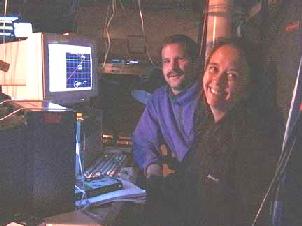 position can be off by as much as 100 m. With ROPOS' time on the bottom
being so valuable, the less time it takes to search for the vent site
the better. So scientists (photo left) must calibrate the transponders
by driving the ship around the area and "fixing" the best GPS positions
of the instruments relative to the positions apart on the seafloor. It
is worth the extra preparation time in order to maximize the time on the
bottom used for exploration, sample gathering, and actual studying of
the vents themselves.
position can be off by as much as 100 m. With ROPOS' time on the bottom
being so valuable, the less time it takes to search for the vent site
the better. So scientists (photo left) must calibrate the transponders
by driving the ship around the area and "fixing" the best GPS positions
of the instruments relative to the positions apart on the seafloor. It
is worth the extra preparation time in order to maximize the time on the
bottom used for exploration, sample gathering, and actual studying of
the vents themselves.
In the biology lab on board, high temperature
microbiology samples that were collected are being maintained for further
studies. One way is to quick freeze the sample using liquid nitrogen.
In order to maintain a 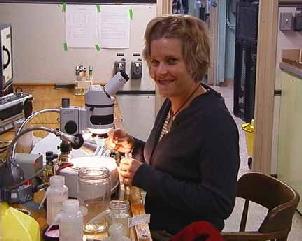 live
sample in culture, the microbes are incubated at high temperature in a
variety of media. (photo right of Jean
Marcus examining samples) These ship board conditions are meant to
simulate what scientist imagine the subsurface seafloor environment may
be like in hydrothemal systems. The scientists bring with them a variety
of nutrient rich media that they believe the microbes will survive and
replicate in. Maintaining these cultures as live specimens enables the
researchers to do some preliminary tests like seeing what temperature
they grow best at or the extreme temperature levels they can exist in.
The real importance of culturing is to create a sample containing an abundant
supply of the microbes to work with back on land.
live
sample in culture, the microbes are incubated at high temperature in a
variety of media. (photo right of Jean
Marcus examining samples) These ship board conditions are meant to
simulate what scientist imagine the subsurface seafloor environment may
be like in hydrothemal systems. The scientists bring with them a variety
of nutrient rich media that they believe the microbes will survive and
replicate in. Maintaining these cultures as live specimens enables the
researchers to do some preliminary tests like seeing what temperature
they grow best at or the extreme temperature levels they can exist in.
The real importance of culturing is to create a sample containing an abundant
supply of the microbes to work with back on land.
I learned a valuable lesson today about ships in rough weather. Be careful of where you stand. The rain that settles on the top decks seeks a path to the lower decks whenever the ship's bow is raised due to a swell. That water will find a stair well or walkway edge, and if you're the unlucky person standing under it, you get a cold shower. Lastly, the honey bear saga continues. It was last seen making deep-sea dives as a guest rock corer. We'll stay after this story.
Bye for now.
June 27
Teacher Log #7 6/27/99
What a great day of science! Today you could barely feel the ship move it was so calm out here. No one noticed though, because ROPOS was in the water busy doing what it does best - scientific exploration under the sea. All systems and equipment worked nearly flawless during the 20 hours ROPOS was in the water. It went in the water at 11:00 pm on Saturday night and is just now (7:20 pm Sunday night) being brought back on deck.
When I arrived in the ROPOS lab this morning for my four hour watch as a frame
grabber (collecting single frame pictures of what were seeing on the video
monitors), the first views of the ocean floor in Axial caldera were of
fabulous lava flows. Though bottom visibility is limited to the
range of the lights, it still provided an excellent perspective of how
the flow of hot lava occurred. Standing by in the lab observing the 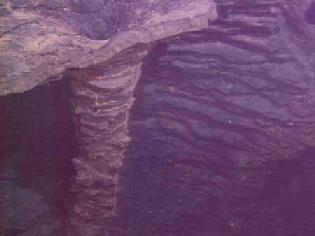 goings on, geologists talked freely about the types of flows and the possible
explanations for the unusual formations. Such names as "sheet",
"lobate" and "pillow" flows were used. Sheet flows were the most
abundant lava form at this site due to the higher eruption rate. Lobate
and pillow lava flows are formed during lower eruption rate, which allows
the seawater to cool and harden the lava faster. This keeps the size
of the formation smaller and produces the more rounded form. My favorite
structures were the "roofs" and "arches" being supported by pillars (photo
left) of lava. When sheet lava flows, the surface may harden but the inner
region is still liquid. The inner liquid region breaks out from below
and continues to spread. As the lava moves out from below, the hardened
surface above may or may not collapse. This is how roof structures are
made. One structure I saw today showed a pillar rising up into a roof
formation that also had a hole right in the center where the pillar and
roof connected (see photo). Water trapped below the flow rose through
this area, slowly creating the pillar and the exit point as one flow after
another laid another layer on the roof. The hole in the roof represents
the inner tube of the pillar where water escaped. Absolutely fabulous
stuff! Take a look in a good geology or earth science book and see what
scientists say about the formations Ive mentioned.
goings on, geologists talked freely about the types of flows and the possible
explanations for the unusual formations. Such names as "sheet",
"lobate" and "pillow" flows were used. Sheet flows were the most
abundant lava form at this site due to the higher eruption rate. Lobate
and pillow lava flows are formed during lower eruption rate, which allows
the seawater to cool and harden the lava faster. This keeps the size
of the formation smaller and produces the more rounded form. My favorite
structures were the "roofs" and "arches" being supported by pillars (photo
left) of lava. When sheet lava flows, the surface may harden but the inner
region is still liquid. The inner liquid region breaks out from below
and continues to spread. As the lava moves out from below, the hardened
surface above may or may not collapse. This is how roof structures are
made. One structure I saw today showed a pillar rising up into a roof
formation that also had a hole right in the center where the pillar and
roof connected (see photo). Water trapped below the flow rose through
this area, slowly creating the pillar and the exit point as one flow after
another laid another layer on the roof. The hole in the roof represents
the inner tube of the pillar where water escaped. Absolutely fabulous
stuff! Take a look in a good geology or earth science book and see what
scientists say about the formations Ive mentioned.
The journey of ROPOS today took us north as we followed the upper south
rift zone of Axial up into an active vent field studied during the
1998 cruise. Many
of the sites showed much less activity or were no longer active at all.
We often talk about life and death in biological terms. What death or
dying is referring to in terms of a vent is the lack of venting due to
the cooling of the magma below the surface. Axial Volcano is a known "Hot
Spot" that happens to sit right in a spreading center known as the Juan
de Fuca ridge. Below this volcano, sits a chamber of magma that powers
the venting that is observed here. Venting is the flow
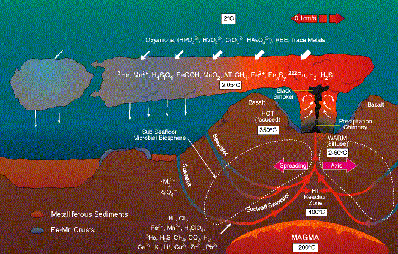 of
fluid (some hotter then others) out of the cracks in the rock that has
formed above it. Sea water is drawn in through the more porous substrate
and cracks in the rocks. Water is heated as it gets closer to the magma
chamber or heat source. Chemical reactions (diagram right, click
for full size) take place in this extremely hot region below the substrate
and that is what makes vent fluid so special to these scientist. The eruption
of 1998 that was studied in great detail last year is maybe showing
its last effects on this area to the north closest to the region of the
rift where it is believed the eruption centered from. A rift is a spreading
center not a specific point. Eruptions along a rift are often a "diking"
process, where along the rift (crack in the ridge) magma pushes upward
over a long narrow region. This forces both sides of the ridge (separate
plates) to separate and grow. This is the basis of sea floor spreading.
South of this point, starting at Marker #33,
which is still very active, scientists are hoping to see continued activity
this year and in the future. This is the aim of
the NeMO project. To observe over a long-term continual basis the
evolution (life and death) of an active volcanic site. If you have a good
oceanographic map which shows the mid ocean ridge system get it out and
look us up, coordinates are given on this web site. Ill be talking more
about its geology and history in future reports.
of
fluid (some hotter then others) out of the cracks in the rock that has
formed above it. Sea water is drawn in through the more porous substrate
and cracks in the rocks. Water is heated as it gets closer to the magma
chamber or heat source. Chemical reactions (diagram right, click
for full size) take place in this extremely hot region below the substrate
and that is what makes vent fluid so special to these scientist. The eruption
of 1998 that was studied in great detail last year is maybe showing
its last effects on this area to the north closest to the region of the
rift where it is believed the eruption centered from. A rift is a spreading
center not a specific point. Eruptions along a rift are often a "diking"
process, where along the rift (crack in the ridge) magma pushes upward
over a long narrow region. This forces both sides of the ridge (separate
plates) to separate and grow. This is the basis of sea floor spreading.
South of this point, starting at Marker #33,
which is still very active, scientists are hoping to see continued activity
this year and in the future. This is the aim of
the NeMO project. To observe over a long-term continual basis the
evolution (life and death) of an active volcanic site. If you have a good
oceanographic map which shows the mid ocean ridge system get it out and
look us up, coordinates are given on this web site. Ill be talking more
about its geology and history in future reports.
In completing todays report, I wanted to mention a few things. First we had a change in luck today, and it may not be just a coincidence. The plastic honey bear that some of us were convinced was causing all our bad luck, was placed in the ROPOS slurp sampler flush bottle ("operation flush"), so that the deep ocean would crush its "bad mojo". Hey, ROPOS just finish a rigorous 19 hour dive. So whatever works, lets stay with it. Second item is the nature of the people in the ROPOS lab at the dives beginning, during and as the hours extend beyond human limits. Words such as excitement, intensity, discovery and even giddy and punchy come to mind. It is a great atmosphere to be part of.
Lastly, yesterdays report proposed a question to you young chemists and physicists.
What equation would you use to calculate the amount of gas given a known volume at a given temperature and pressure?
Well the correct answer is : PV = nRT
where P represents the pressure, V is the volume and T is temperature. R
is a gas constant (with a value of about .0821 L Atm/Mol deg C) and you
solve for "n".
You end up with: n = PV / RT.
Bye for now.
June 26
Teacher Log #6 6/26/99
My day started as usual by throwing on some warm clothes (its chilly out here) and stepping out onto the weather deck (there is a reason they call it that) to check the weather. I start my observation with a view of the water. From that first look I can determine whether or not were moving for one thing, but it helps me determine what the sky and wind conditions are. Like all the other mornings, the water was gray (cloudy sky) and choppy with a few white caps (moderately windy - 10 to 15 mph). We have had decent weather (Im told that it could be a lot worse). Almost every day we have been getting a break in the clouds where the sun is shinning and the breeze picks up. It is always nice to see blue ocean water. Keep your fingers crossed and say a few kind words, so that our nice weather holds (it is not possible to use ROPOS in rough water).
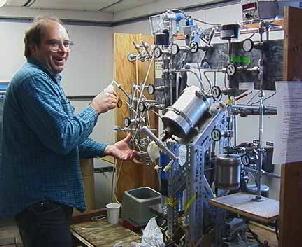 Leigh Evans working on the vacuum extraction system for getting samples of helium from ROV samples on board the Thompson. |
Question for all you chemistry students out there:
What equation would allow you to calculate the amount of gas collected in
the process above?
Check tomorrow for the answer.
One of the ways that Leigh can check to see what percent of his sample came from the vent fluid versus the sea water surrounding it, is to determine how much Magnesium is in the fluid left over from the separation process. Pure vent water will have no Magnesium, while seawater normally has around 50 ppm (parts per million).
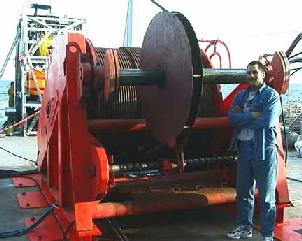 One of the more important pieces of equipment that never gets mentioned
is the winch (right) used to lower and raise ROPOS into and out of the
water. It is so large it takes one entire triple axle tractor trailer
to transport. It weighs over 64,500 pounds. The major component of the
load it carries when ROPOS is in the water is the cable (which is 3500
meters in length). The more cable that is paid out in deployment of the
ROV, the greater the load. The cage, which normally is stationed about
30-50 m above the sea floor, also has a winch that is responsible for
recollecting the tether which attaches ROPOS to its cage (no more than
150 meters) and does not have a load responsibility due to the neutral
buoyancy of ROPOS.
One of the more important pieces of equipment that never gets mentioned
is the winch (right) used to lower and raise ROPOS into and out of the
water. It is so large it takes one entire triple axle tractor trailer
to transport. It weighs over 64,500 pounds. The major component of the
load it carries when ROPOS is in the water is the cable (which is 3500
meters in length). The more cable that is paid out in deployment of the
ROV, the greater the load. The cage, which normally is stationed about
30-50 m above the sea floor, also has a winch that is responsible for
recollecting the tether which attaches ROPOS to its cage (no more than
150 meters) and does not have a load responsibility due to the neutral
buoyancy of ROPOS.
ROPOS is geared up for another dive, the crew is optimistic of great successes to come. Keep following the action. Bye for now.
June 25
Teacher Log #6 6/25/99
The major component of Dive 485 was the collection of vent fluid using the specially designed Vent Fluid sampler. This device is designed to collect up to fourteen 800 ml containers of vent fluid from specifically targeted places within the vent fluid stream. This allows for a discrete sample at a known temperature. The sampler is built to fit the ROV just below the body and towards the front so the sampler is visible during the operation. The actual collecting probe is fitted to one of ROPOS arms for placement accuracy. The sampling operation during todays dive was successful.
When ROPOS is in action down along the ocean floor, many of the scientist and technicians are viewing the actions on monitors placed around the ships labs. During the ascent back to the ship, those with samples on the way to the surface begin preparation for necessary lab work to be done. Samples of vent fluids and biological materials are required for their research, so when these samples finally reach the deck, the sense of urgency takes over as the "shelf life" for these samples is quite limited. No sooner then it takes to tie off and secure ROPOS and its cage, samples are whisked away into the respected lab areas.
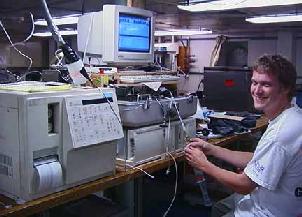 Andy Graham running gas chromatograph samples |
 Bill Chadwick and Susan Merle manning the ROPOS navigation center in the main ROPOS control station |
June 24
Teacher Log #5 6/24/99Dive 484 started with high hopes but was faced with many obstacles. The plan was to complete the objectives of yesterdays Dive 483, collect additional biological samples at Cloud Vent, and finish with a test run of the Imagenex sonar mapping system. Unfortunately, increasing winds and swell size and a poorly functioning bow-thruster, one of the three used to maintain the ships position during dives, caused the dive to end early.
After making a few collections of specimens and microbial traps, 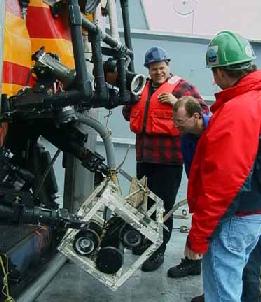 ROPOS went about the task of mapping the area known as Marker 33, a well-studied
active vent site. An attempt to survey Marker 33 with the Imagenex was
postponed due to the temporary problem with the bow-thruster. On the way
back to the cage, ROPOS was positioned to retrieve a time-lapse camera
deployed during the 1998 cruise. This is when the real excitement began.
After positioning the camera so that ROPOS could grab it with both arms,
difficulty began when the detachable weight (used for ballast) on the
ROV would not release. While the pilot began dragging the weights in an
attempt to detach them, an alarm sounded indicating little to no hydraulic
oil registered and the system was failing. After restarting the system,
the motor on ROPOS refused to restart. Everything had come to a stop.
Well you dont send down an extremely important research vessel to the
bottom of the ocean without a few fail safe systems. The pilot and support
technicians directed the cage to begin slowly pulling ROPOS back to it
using the tether cable that connects the ROV to the cage. After bringing
ROPOS to within 40 m of it, the winch on board the Thompson began the
slow process of bringing both units to the surface. As the cage and ROV
got closer to the surface they were able to restart the motor of ROPOS
(remember it is used under extreme pressure and that may have prevented
it from starting earlier). ROPOS was then positioned in the cage as normal
and brought safely back on deck. (photo right)
ROPOS went about the task of mapping the area known as Marker 33, a well-studied
active vent site. An attempt to survey Marker 33 with the Imagenex was
postponed due to the temporary problem with the bow-thruster. On the way
back to the cage, ROPOS was positioned to retrieve a time-lapse camera
deployed during the 1998 cruise. This is when the real excitement began.
After positioning the camera so that ROPOS could grab it with both arms,
difficulty began when the detachable weight (used for ballast) on the
ROV would not release. While the pilot began dragging the weights in an
attempt to detach them, an alarm sounded indicating little to no hydraulic
oil registered and the system was failing. After restarting the system,
the motor on ROPOS refused to restart. Everything had come to a stop.
Well you dont send down an extremely important research vessel to the
bottom of the ocean without a few fail safe systems. The pilot and support
technicians directed the cage to begin slowly pulling ROPOS back to it
using the tether cable that connects the ROV to the cage. After bringing
ROPOS to within 40 m of it, the winch on board the Thompson began the
slow process of bringing both units to the surface. As the cage and ROV
got closer to the surface they were able to restart the motor of ROPOS
(remember it is used under extreme pressure and that may have prevented
it from starting earlier). ROPOS was then positioned in the cage as normal
and brought safely back on deck. (photo right)
The day was not without its triumphs. The time-lapse camera was successfully brought to the surface, the film is being retrieved, and the instrument cleaned and prepared for deployment at the bottom again. This camera was placed by ROPOS a year ago under the watchful eye of Dr. Verena Tunnicliffe of the University of Victoria. The goal was for the camera to document the sequence of biological changes in a specific location along a new vent. It is hopeful that the pictures will show how a vent ecosystem changes over a period of time. Some 225 frames of film were shot by the camera over the 10 months it has been down there. This is just one of the ways scientists can extend their visiting time on the bottom without actually have to be on site.
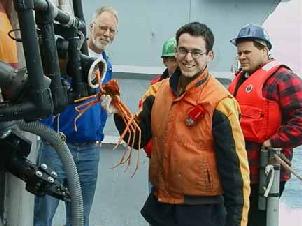 On the lighter side
of the more intense happenings of the day was the great crab capture (left).
Crabs in these extreme ecosystems are believed to be the top carnivores.
In order to determine the flow of nutrients through this system, the capture
and analysis of these hard to come by species is a must. After a spirited
chase, escape, and chase again, ROPOS and the pilot were able to capture
one of these critters. One crab was initially placed in the biobox and
as soon as it saw a slim avenue of escape, took advantage of the opportunity.
But fortunately another crab was located and was successfully collected.
Crab salad was not on the menu in the mess tonight. This particular specimen
smelled bad due the hydrogen sulfide from the vent environment.
On the lighter side
of the more intense happenings of the day was the great crab capture (left).
Crabs in these extreme ecosystems are believed to be the top carnivores.
In order to determine the flow of nutrients through this system, the capture
and analysis of these hard to come by species is a must. After a spirited
chase, escape, and chase again, ROPOS and the pilot were able to capture
one of these critters. One crab was initially placed in the biobox and
as soon as it saw a slim avenue of escape, took advantage of the opportunity.
But fortunately another crab was located and was successfully collected.
Crab salad was not on the menu in the mess tonight. This particular specimen
smelled bad due the hydrogen sulfide from the vent environment.
Dive 484 is now in the books and on tape, ROPOS is being configured for Dive 485. We are hopeful that the problems that developed earlier today will soon be fixed and that the much anticipated vent fluid sampler will be put into action. On a side note, there is a rumor about an abducted plastic "honey bear" being the jinx aboard the Thompson and causing all the problems with ROPOS. Well keep you posted on this development. Bye for now.
June 23
Teacher's log..
Teachers Log #4 6/23/99 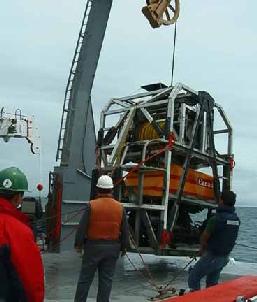 Dive #R483
finally got under way at 03:30 this morning with ROPOS
reaching the targeted site known as Marker #33 at about 04:45. At 1500
meters depth, it takes a little over an hour for the sub to reach the
bottom. The goals for this first dive were to make a video survey of site
#33 before disturbing it by sampling specimens, to retrieve equipment
left from the 1998
cruise and to deploy new equipment for current research projects.
After the survey was completed, ROPOS was to go about making the necessary
sample collections of vent fluids, gases and life forms. The final part
of the dive before further exploration of the this area and possibly other
sites close by was to deploy osmotic
fluid samplers and analyzers along with bacterial
traps and bioboxes
and retrieve similar equipment left from a previous cruise. Scientists
were optimistic that this could be a long lasting dive that could accomplish
quite a bit of work.
Dive #R483
finally got under way at 03:30 this morning with ROPOS
reaching the targeted site known as Marker #33 at about 04:45. At 1500
meters depth, it takes a little over an hour for the sub to reach the
bottom. The goals for this first dive were to make a video survey of site
#33 before disturbing it by sampling specimens, to retrieve equipment
left from the 1998
cruise and to deploy new equipment for current research projects.
After the survey was completed, ROPOS was to go about making the necessary
sample collections of vent fluids, gases and life forms. The final part
of the dive before further exploration of the this area and possibly other
sites close by was to deploy osmotic
fluid samplers and analyzers along with bacterial
traps and bioboxes
and retrieve similar equipment left from a previous cruise. Scientists
were optimistic that this could be a long lasting dive that could accomplish
quite a bit of work.
At first ROPOS showed no ill effects of being kept onboard the ship for longer then anticipated. The dive began quite smoothly. After an initial survey of the site it was decided that samples of organisms would be made using the "slurp gun". The slurp gun is a suction-type of device that looks like a vacuum cleaner hose connected to a vacuum system. It is used for collecting samples of bacteria, gastropods (snail like animals), polynoids (scale worms) and tubeworms. One arm of ROPOS is specially configured with the vacuum hose and it is brought into close proximity to the desired group of organisms. After being ingested into the system they are directed toward a specific collection bottle where they remain until ROPOS returns to the deck of the ship. Sometimes too much is ingested and clogs develop. This is what happened today and unfortunately it stopped all suction sampling. No fretting the small problems, ROPOS went about collecting a small bush of tubeworms using the special articulating "claw". These specimens were then placed in bioboxes at the front of ROPOS. There they stayed until they reached the surface and scientists removed them for study and preservation. So we had one small glitch in the collection process but science continues on.
Before deploying the various samplers and analyzers, vent fluid was collected in order to measure the amount of particular gases and isotopes, specifically helium. Inserting the probe end of a gas-fluid collector into the vent using a robotic "claw" may appear to be easy, but just try it controlling a robot arm some 1500 m away where depth perception on a video screen is limited and you get no sense of touch feedback from the system. After numerous tries, success finally occurred. Following this operation, osmosamplers and analyzers were place along the actual vent opening. An "osmo" sampler/analyzer is designed for long-term stays at vent sites. Samplers simply collect the fluid slowly over a period of a year and analyzers actually sample the water at regular intervals and analyze them right there on the bottom. Data collected from the analysis of the water sampler is kept in a water-tight unit. The two that we deployed today will be recovered in about 2 weeks and the data will be analyzed on board to determine if they actually function correctly. It the analyzers are working correctly they will both be deployed again for a stay of up to a year on the bottom. What makes these devices so unique is that they don't require battery or power source for the actual collection of the fluid sample. What powers these samplers is the natural tendency of fluid (water) to cross a membrane to balance out the concentrations of dissolved particles.
Remember the discussions of osmosis and diffusion in biology class. Take a red onion cell and place it into salt water and the red onion cell will lose water. You'll find in the center of that red onion cell a small spherical shaped red ball of dense cellular material. When you reverse this process by placing the red onion cell in fresh or distilled water, the flow of water reverses back into the cell. Well that is how these "osmo" samplers and analyzers work. They'll run continuously until the balance of dissolved particles equals out or until the very narrow tubing used clogs up. This can often be controlled by the use of a biocide agent or acidic component within the sampler that limits the metallic buildup that these microbe down here can create. Great stuff is being created to collect specific things!
Sitting today on my first watch as a frame grabber (saving still images from video images), I got to watch a true team in action, all working for the same goal of creating a successful dive. Scientists collaborated on where to go, what specific locations along the vent might provide the greatest quantity and best quality results. When questions were asked the answers were given quickly and genuinely along with examples of where on the video monitors that item, process or specimen in question could be found. No egos in the way to limit the learning process. The best part of my watch came in observing the interactions between the scientists and the ROPOS team members. For all of ROPOS' actions and abilities, behind the scene are 7 members who provide the technical skills to operate and maintain operations. For each dive two members act as pilot and copilot. The pilot flies the ROV around in liquid space, taking it wherever the scientist needs. Working closely with him is the copilot who oversees the use of the working articulated arm. These two work in unison bringing about the collective goal of each scientist whose experiment is the focus at that particular moment. The duration of a dive is directly related to the tasks to be performed, the weather, and the possibility of unforeseen problems. It was an unforeseen problem that led to aborting dive R483. During the deployment of the last osmosampler from the elevator, the tether for ROPOS became entangled and developed a kink in the line. Rather then tempt the sea gods of misfortune, ROPOS was brought back on deck. As it stands now, ROPOS needs some repair work which may include shortening the tether a bit. If the tech guys (the magnificent 7 men of ROPOS) have anything to say about, ROPOS will be ready to dive again by midnight tonight.
As for site Marker #33, we will return for completion of dive R483, which includes the recovery of our elevator and samples. Until then, we'll be moving on to other sites along Axial Volcano's ridge system. The geologists are preparing their equipment for more coring and the fluid, gas, and biological samples that have been collected are already being analyzed by the scientific staff.
June 22
The Thomas G. Thompson
arrived on site at Axial volcano around 20:00 (8:00 p.m.) Monday night.
The science staff and technicians eagerly
began making final preparations for ROPOS first of many dives. The first
step in getting ROPOS in the water for a dive was to turn on the transponders
left from the last cruise to Axial back in 1998. The transponders send
out an acoustic "ping" at a specific frequency. The time is takes for
the ping to reach the sub determines how far away the transponders are.
Triangulating several transponders allows one to determine the position
of ROPOS.  After the transponders located on the sea floor were turned on, the next
problem was in getting the vent fluid water sampler (photo left) ready.
Dive time finally became a reality at about 03:00 (3:00 am) after many
hours of waiting. You must be a patient individual when on a research
cruise. (Boy will my wife be impressed, me being patient). DiveR482 never
made it to the bottom. This first attempt lasted a short time and depth
(about 100 of the over 1500 meters it must travel to the bottom). Problems
with the air in the ROVs tether cable (umbilichord) caused the crew to
raise ROPOS back to the ship. On the second attempt, at about 06:00 (6:00
a.m.), ROPOS made it down to slightly over 400 m before communication
broke down between the ship and the vent fluid sampler. Since one of the
main goals of this dive was the collection of water samples from the vent
site #33, it was canceled because no sampling and data was being collected.
After the transponders located on the sea floor were turned on, the next
problem was in getting the vent fluid water sampler (photo left) ready.
Dive time finally became a reality at about 03:00 (3:00 am) after many
hours of waiting. You must be a patient individual when on a research
cruise. (Boy will my wife be impressed, me being patient). DiveR482 never
made it to the bottom. This first attempt lasted a short time and depth
(about 100 of the over 1500 meters it must travel to the bottom). Problems
with the air in the ROVs tether cable (umbilichord) caused the crew to
raise ROPOS back to the ship. On the second attempt, at about 06:00 (6:00
a.m.), ROPOS made it down to slightly over 400 m before communication
broke down between the ship and the vent fluid sampler. Since one of the
main goals of this dive was the collection of water samples from the vent
site #33, it was canceled because no sampling and data was being collected.
Scientists never stop working though. During the interval between the 1st and 2nd attempt of the ROPOS dive, scientists decided to use the CTD rossette sampler (photo above in science report)(Conductivity, Temperature, and Depth) for collecting water samples from a general area around and above the vent. The CTD sampler not only collects water samples but also analyzes the water it travel through on its way down which helps narrow down the target, providing scientists with "real time" data. Used for tracking"plume events", the relationship between the waters conductivity, temperature and the depth it is found in aids scientists to zero in on plumes or discharges of fluids from vents. This allows scientists to decide if a site in question is going to be a good one for sampling. In past explorations samples needed to be brought back on deck to be analyzed. You will read a lot about the "signatures" of vents and lava flows. This represents the chemical makeup of the water or rock in question. A signature may represent a large area or specifically small area. Water samples collected by the CTD sampler are now being analyzed. Julie Huber (University of Washington) a Thermophilic Microbiologist is using the water samples collected to look for microbes that are suspended within the vent fluids. Her goal is to determine if the microbes found here are common to all vent and oceanic ecosystems or if they are a very specific form, one that is only found here but not at other vent sites. One of the many studies going on here and around the world is the determination of micro and macro fauna of vent sites. Bacteria make up the basic ground floor level and a determination of where specifically these organisms actually live is an important part needed before other studies can be completed.
Christian Levesque ( University of Quebec in Montreal) is a Biologist seeking determine the relationships that develop based on the transference of nutrients from one organism to another (food chains and food webs). At the present time, water samples collected by CTD will be sealed up by Christian and sent back for analysis in Montreal. In Montreal, Christian will be trying to chemically determine the background signature of chemical elements in the vent fluid and sea water (there is a difference between the two so keep that in mind). Isotopes of carbon and nitrogen will hopefully be followed through the various organisms so as to identify the pathways within the ecosystem. No easy task for no air can come in contact with these samples or they become contaminated. So they must be handled carefully.
John Chadwick and Mike Perfit have been busy with collecting samples of lava flows using the rock corer. This simple device carries small plugs of wax that fragments of lava adhere to after the corer smashes down from its decent some 1500 m. The corer travels down at a rate of about 50m per minute. When the corer is retrieved, any and all fragments are removed from the wax for analysis back in labs at the University of Florida where John is working toward his Ph.D. under Mike. Working side by side in the lab, John removes the fragments from the wax with tweezers and Mike takes the remainder of the wax with the fine fragments and boils the wax in a cup of water to melt the wax away from the fragments. This appears to work great as the boiling water leaves behind numerous rock chips on the bottom of the cup. All the fragments are important. The more fragments you get, the wider the array of geochemical tests you can perform, and hopefully more information you can get from those tests. This is all just another step in coming to some conclusion about the history of Axial Volcano and trying to identify the geochemistry of the rocks along with the possible chemical evolution of this areas geology.
We are all back in the waiting mode, so scientists are back to checking equipment, going over maps for new site possibilities, and sleeping after the long night of waiting. Rock collecting is continuing as the vent fluid sampler goes in for repairs. The "elevator" is being prepared for the next dive (whenever that will be - remember patience) where samples of living creature along with sensing and data collecting equipment will be retrieved. Remember to send in your question and pass along our web site to your friends. Bye for now.
June 21
Our adventure began at about 1400 (2:00 p.m.) yesterday when we finally set
sail from the Port of Victoria. At
about 1845 (6:45 p.m.) we stopped and tested the ROV ROPOS in deeper water
to check the various systems and give it a pressure test. The test was
carried out in about 28 meters of water. All systems appeared to be working
fine so it 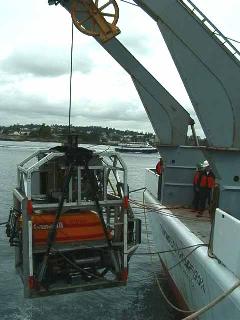 was brought back aboard and tied down for the voyage. Getting an ROV off
and on a ship is no easy task. Each time ROPOS leaves the ship, safety
measures must be taken to ensure that it won't come crashing back into
the boat due to the never ending undulations of the water. To sufficiently
secure ROPOS from swinging free, 5 lines are manned from various angles
and they provide tension so that ROPOS can be lifted off the deck and
place directly into the water behind the ship. A chief mate (person in
charge of conducting back deck operations) directs the crane operator
along with those manning the lines. Once ROPOS is in the water and after
it has completed its mission, 3 cable lines are attached when it reaches
the surface. These provide the same function coming back on board as the
five manned lines going out. These 3 lines are powered with winches which
are each manned by crew members who know what's going on. Keeping ROPOS
safe and secure is no easy job, nor is it one that is taken lightly. If
there is a down time on a scientific voyage, we experienced it late last
night and earlier this morning while still in transit to the field site.
Labs were empty and the technicians and scientists that man them were
not to be found. The effects of being at sea could also have something
to do with this. As the ship makes it way to the site of Axial Volcano
we seem to be rolling back and forth a lot. Try typing a term paper on
a children's roller coaster or a rapidly changing elevator. Besides teaching
high school science, I also coach basketball. We call a specific positioning
of the players body when they catch the ball a "Triple Threat" position
(you can shoot, pass or dribble from it). Well, on board a ship rolling
along I've been practicing that position a lot trying to keep my balance,
walk in a straight line and not loose my dishes during meal breaks.
was brought back aboard and tied down for the voyage. Getting an ROV off
and on a ship is no easy task. Each time ROPOS leaves the ship, safety
measures must be taken to ensure that it won't come crashing back into
the boat due to the never ending undulations of the water. To sufficiently
secure ROPOS from swinging free, 5 lines are manned from various angles
and they provide tension so that ROPOS can be lifted off the deck and
place directly into the water behind the ship. A chief mate (person in
charge of conducting back deck operations) directs the crane operator
along with those manning the lines. Once ROPOS is in the water and after
it has completed its mission, 3 cable lines are attached when it reaches
the surface. These provide the same function coming back on board as the
five manned lines going out. These 3 lines are powered with winches which
are each manned by crew members who know what's going on. Keeping ROPOS
safe and secure is no easy job, nor is it one that is taken lightly. If
there is a down time on a scientific voyage, we experienced it late last
night and earlier this morning while still in transit to the field site.
Labs were empty and the technicians and scientists that man them were
not to be found. The effects of being at sea could also have something
to do with this. As the ship makes it way to the site of Axial Volcano
we seem to be rolling back and forth a lot. Try typing a term paper on
a children's roller coaster or a rapidly changing elevator. Besides teaching
high school science, I also coach basketball. We call a specific positioning
of the players body when they catch the ball a "Triple Threat" position
(you can shoot, pass or dribble from it). Well, on board a ship rolling
along I've been practicing that position a lot trying to keep my balance,
walk in a straight line and not loose my dishes during meal breaks.
As I close this message we are about 83 nautical miles from our destination where we as a team hope to develop a new baseline understanding of what is now happening at Axial Volcano and the associated vent sites. If you remember a year ago the team researched in depth what happened during the 1998 eruption and came away with a great deal of data and new ideas. We will be filling you in on some of the findings from that voyage along with what is going on out here this year so stay tuned for more.
Bye for now.
June 20
Happy Father's Day! At long last, final preparations are being made for us to leave Victoria and head out to sea. Scientists have set up, checked and rechecked equipment, run baseline tests and tied down their equipment. The remotely operated submersible, affectionately known as ROPOS, got its first test in the water from the dock at 11:45 a.m. and managed to checkout OK with little trouble. ROPOS will get another deeper test later tonight as we move out to sea. We are coming up to the no turning back point for those of us who still are not sure why we are here (like me). Things that we will be writing to you about from this voyage will include, remotely operated vehicles (ROVs) and ROPOS, the "Cage", tethers and umbilicords, and special deep water cameras and other assorted equipment that will be attached to ROPOS. While waiting on board over the past 24 hours, I have met many interesting individuals whom you will meet later and have discussed research plans with a number of the scientists. Some of the equipment I have been able to observe include the CTD Rossette sampler, osmotic sampler and osmotic analyzer. These last two are both designed for long term deployment on site. The sampler was used last year and has an incredibly simple design while the analyzer is new and will be tested early in the trip and then be retrieved for data collection. If it works well it will be deployed again for a longer stay on the bottom. More to come on both these unique tools. We have just been given the call for all ashore who are going to shore so it's departure time at last!! Have a great time following the cruise of the Thomas G. Thompson. We look forward to any question you can send our way and pass the word along to your friends about what is going on out here so that they to can check in with us. Bye for now.
Wecoma Teacher-At-Sea logbook:
June 16, 17, 18, 19, 20, 21, 22, 23, 24, 25 26 28 28June 28
Day 13, Monday 6/28/99
The Wecoma is cruising rapidly for its homeport at 12.5 knots. When we reach homeport we will have travelled 1275 miles. The scientists are busy deconstructing their equipment from the laboratory on the ship that has been an effective working area for our two-week cruise. The final reports are being entered into the computer. Everyone has the look of wanting to get home. I too look forward to flying back to Los Angeles tomorrow, but ... it is almost as if summer camp is over. I know I will not see the new friends I have made aboard this vessel for some time. Most of the scientists are based in Seattle at PMEL/NOAA. They will be working on the analysis of the collected samples for a long time at their NOAA/PMEL laboratories.
The opportunity to investigate hydrothermal activity at Axial Volcano on the Juan de Fuca Ridge has been educational and rewarding. I will use the knowledge gained with my students at Stephen Foster Elementary and share with others as well. I am glad you joined us on the NeMO site and I hope you will follow the study that Dr. Ed Baker and fellow scientists continue enthusiastically.
Fair seas ... sail on in
education,
Ms Deck
June 27
Day 12, 6/27/99Following lunch the CTD was deployed. The CTD has been a valuable member of the scientific cruise collecting data on conductivity, temperature and depth. Other instruments are occassionaly added to elicit additional data and information from our sawtooth tows.
Dr Richard Feely has added an insitu pump to the instrument's ability to collect particles in the water column. This instrument filters sea water at depth in the natural environment before chemical transformation can occur. The pump allows the scientists to collect samples throughout the year and measure changes in composition over time. It is like having a laboratory in the ocean depths. Dr. Feely would like to add this insitu pump to the moorings that hold the MAPR (Miniature Autonomous Plume Recorder). A signal could then be transmitted to the pump to collect seawater, filter the water at depth, and then relay data to the laboratory on land. The scientists would like this technique to be added to the data collection process at Axial Volcano.
It is amazing to me how extensive the data collection has been over the last two weeks. We have acquired a vast amount of information that will take scientists months to interpret and place into understandable charts, graphs and written reports.
Rachel Schackelford and Don McGee, University of Hawaii research team, have begun to pack away their portion of the laboratory. It is beginning to look like Christmas with large boxes and crates taped and stacked.
Dr. Ed Baker, chief scientist NOAA/PMEL, has worked with all scientists aboard to ensure that everyone has collected everything they need from the Cleft Segment. The last tows and cast will be collected tonight.
When I awake tomorrow morning the Wecoma will be moving towards its homeport, Newport, Oregon. We'll make port in 22 hours.
Check with me tomorrow to see what our cruise home will bring.
Fair seas,
Ms. Deck
June 26
Day 11, Saturday 6/26/99
Our day was filled with a long tow-yo deployment along the Cleft segment. The sawtooth pattern of our tow was marked on the large chart on the lab's map table. More samples were collected for chemical analysis and interpretation.
Ron Greene,
Research Assistant OSU/CIMRS uncoils shiny copper tubing on the floor
of the dry lab. He then carefully measures and cuts the tubing into 2
ft lengths. Each tube is capped at both ends to keep them dust free. The
scientists later attach clear aquarium-type tubing to drain sea water
from the Niskin Bottles when the 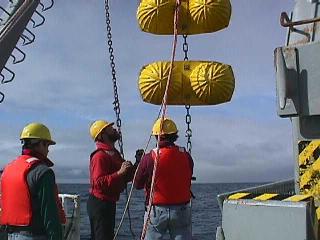 rosette returns from the deep. Bubbles are removed by pounding on
the tubing with a small metal rod. I enjoy watching the scientists for
it is as if they are playing a percussion instrument in an orchestra.
Ron explains that gases
from the earth's mantle enriches the hydrothermal plume signal with both
3He and 4He (Helium). Both are stable isotopes with 4He being 1,000,000
times more abundant than 3He. The seawater holds many answers to questions
scientists ask. After collecting seawater into copper tubing, the dissolved
gases are later removed at the PMEL laboratory in Newport, Oregon. Helium
gas is conservative and inert and only affected by dilution from the vent
site onward. It does not decay, nor react chemically or biologically with
other elements. It is an ideal tracer. In the Newport laboratory the collected
seawater is analyzed with a sensitive mass spectrometer to isolate helium
from the other gases. The 3He and 4He atoms are counted and information
of this important element in the Western Pacific is completed.
rosette returns from the deep. Bubbles are removed by pounding on
the tubing with a small metal rod. I enjoy watching the scientists for
it is as if they are playing a percussion instrument in an orchestra.
Ron explains that gases
from the earth's mantle enriches the hydrothermal plume signal with both
3He and 4He (Helium). Both are stable isotopes with 4He being 1,000,000
times more abundant than 3He. The seawater holds many answers to questions
scientists ask. After collecting seawater into copper tubing, the dissolved
gases are later removed at the PMEL laboratory in Newport, Oregon. Helium
gas is conservative and inert and only affected by dilution from the vent
site onward. It does not decay, nor react chemically or biologically with
other elements. It is an ideal tracer. In the Newport laboratory the collected
seawater is analyzed with a sensitive mass spectrometer to isolate helium
from the other gases. The 3He and 4He atoms are counted and information
of this important element in the Western Pacific is completed.
The meals served aboard the Wecoma have been more than wonderful. The food is served cafeteria style with a menu posted on the bulletin board before each meal. Doug Capps, cook, and Lee Helton, messman, have provided us with a wide variety of culinary delights. We all enjoyed the fare this evening. Salad bar with prawns, Soup of the day: Chicken noodle. Fillet Mignon, New Zealand Rack of Lamb, baked Yams, green peas with proscuitto and onions, fresh baked rolls followed by desert: chocolate mousse. With meals like this I'd call Doug and Lee top class Chefs!
Have you eaten all your vegetables? To be a scientist it is important to be of strong mind and body.
Fair seas,
Ms. Deck
June 25
Day 10, Friday 6/25/99
During the evening hours we completed our data collection at Axial Volcano
caldera and moved to a new location. We are now located on the Cleft
segment at the southern end of the Juan
de Fuca ridge, almost due west of the homeport of our vessel, Newport,
Oregon. Systematic studies of the hydrothermal vents on the Juan de Fuca
Ridge originated here in 1980, only two years after the very first vents
were discovered in 1977 on the East
Pacific Rise. The northern Cleft segment, which we are studying today,
has been studied every year since 1986 by the Vents
Program. A "mega-plume" 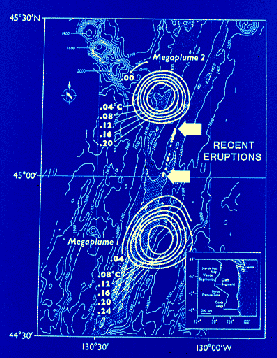 lava eruption in 1986 at this site produced great mounds of pillow lavas
and a new vent field. This eruption also released a "mega-plume"
- enormous releases of hydrothermal fluid that rise a kilometer above
the seafloor - the first ever observed in the ocean (image right, click
for full size). The lava flows of the northern Cleft segment are distinctly
younger than the flows found elsewhere on the segment. Scientists estimated
them to be less than a few hundred years old.
lava eruption in 1986 at this site produced great mounds of pillow lavas
and a new vent field. This eruption also released a "mega-plume"
- enormous releases of hydrothermal fluid that rise a kilometer above
the seafloor - the first ever observed in the ocean (image right, click
for full size). The lava flows of the northern Cleft segment are distinctly
younger than the flows found elsewhere on the segment. Scientists estimated
them to be less than a few hundred years old.
We will be taking two tow-yos along this segment. The first tow will be almost twenty-seven nautical miles with a duration of over 18 hours. There has been evidence of a decrease of hydrothermal activities and plume discharge over this site, suggesting that the system is continuing to cool down.
Dr. Joe Resing has mounted the "Submersible System Used to Assess Vented Emissions" (SUAVE) on the CTD rosette to measure concentration of Mn (Manganese), FeII (Iron) and H2S (Hydrogen Sulfide) for comparison with data from previous years. This instrument reacts with sampled water to form colors specific to the elements we are looking for. The concentrations are measured by the intensity of the color. This method is known as the colorimetric technique. The SUAVE has its own "personality". It has a bright yellow frame with a multitude of tubes, detector LED's (Light Emitting Diodes) and 12 plastic baby bottles with colorful cartoon designs. Even with its humorous exterior the SUAVE has been a significant surveyor for the scientists.
While working on the fantail of the Wecoma we were visited by a young male Northern Fur Seal. He swam about our ship entertaining us with his antics. He jumped in and out of the swells with great speed occasionally giving us a look with his cute dog-like face.
The activities on board go on like clockwork with the crew and scientists focused on the tasks to be completed. The lab and bridge is bursting with activity continuosly 24 hours a day.
It is exciting for me to continue to spot whale blows on the horizon. Today I added Humpback whales to my list of cetaceans documented. These were easily identified due to their bumpy rostrum, rorqual streaks, blowhole placement and dorsal fin. The largest of the two was near fifty ft. in length, while the smaller was between twenty five and thirty ft. I continued to search the horizon for additional sightings.
Check the NeMO site tomorrow.
Fair seas
Ms. Deck
June 24
Day 9, Thursday 6/24/99
A majority of my day focused on our ship, the Wecoma. The name Wecoma means "sea" in the language of the Northwest Native American Chinook tribe. This name is certainly appropriate considering the role of the ship in our research program at NeMO (The New millenium Observatory).
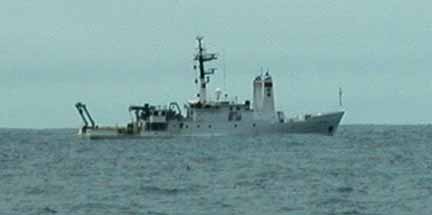 Photo of Wecoma taken from R/V Thompson at Axial Volcano, 1999. |
The deck on the fantail has numerous boltdowns to secure scientific equipment for travel from one location to the next station or research area. It is a great place to enjoy the view of the open ocean. Just wear a jacket!
A Marine Technician is assigned to the ship for each cruise to coordinate scientific operations with the scientists. Daryl Swensen is our well-trained support. He is always prepared and ready to answer any of my questions.
There are a variety of winches aboard - hydrographic, trawl, deep sea traction as well as others. These winches have spooled wire for mooring recovery and deployments. They make a great deal of noise when operating.
My stateroom (bedroom) is shared with Sharon Walker, oceanographer, NOAA/PMEL and Rachel Schackelford, University of Hawaii graduate student. I have a bottom bunk on the starboard (right) side. We are lucky to have a head (restroom) and shower inside our stateroom. It is cozy but with plenty of space for the amount of time spent in it. My watch is from 8am - 12pm, and 20:00 - 00:00 (8pm- 12am) each day. But I am usually around the lab or on the fantail more than that - I don't want to miss anything.
Join me tomorrow so you don't miss anything.
Fair seas,
Ms. Deck
June 23
Day 8, Wednesday 06/23/99 
This morning's schedule kept all aboard busy with deployments. The crew and scientists worked together to place three moorings on the bottom before lunch. Each mooring is made up of a variety of instrument packages. The instruments will monitor selected parameters at selected depths. The instruments measure water temperature, current direction and speed, as well as particles in the water column. In addition to the NOAA/PMEL equipment, Monterey Bay Aquarium Research Institute (MBARI) of California has sent out two OSMO samplers to be added to the mooring's line. This instrument will store small samples of water in a plastic tube system within the unit. A chemical analysis will later be done on this seawater. It will be a year before these moorings will be collected and the data added to the permanent record of activity here at the vents' site. Scientists can learn a great deal about the vents' site and plumes with the instruments deployed by the NOAA/PMEL Vents Program. The New Millenium Observatory (NeMO) is definitely an advantage to the research and investigations taking place here at Juan de Fuca Ridge. Scientists all over the world share information to help prove the importance of volcanic eruptions and earthquakes on the mid-ocean ridges to these unique eco-systems. We have a great deal to learn.
To recover the mooring lines with all of the equipment an acoustic release is placed near the bottom of the line. When the research ship returns for collection, the release is tripped by activating the unit with an acoustic impulse, similar to a garage door opener. The large bright yellow, plastic, "hard hats" that contain 17 inch glass balls pop the mooring line with instruments connected to the surface. The data is then read by ship's computer for later analysis. Each MTR, MAPR and current meter is calibrated, battery changed and checked out. Then the mooring cycle begins again.
Two thirty ft. Fin Whales cruised off our bow on the starboard side at 16:38 (4:38 pm). Their smooth dark bodies traveled close together within 70 yards of the ship. The Captain reduced speed after sighting the whales. You could make out the line of the mouth and eye as they moved towards us within 50 ft of the ship. They then sounded and continued to swim away in the open ocean. For me, another exciting moment aboard the Wecoma.
Dall's porpoise joined us to play in our wake as the first sunset of our eight day voyage was visible was on the horizon. Tomorrow we will complete our work on the vent site with two more tow-yo's. Dr Richard Feely has stated that this will give us a uniform geographic distribution here on the Juan de Fuca Ridge. Join us!
Fair seas,
Ms Deck
June 22
Day 7, Tuesday 6/22/99
Morning brought a light fog across the waters. When on deck a jacket and a hard hat were necessary to stay warm while preparing for a CTD cast. Inside the dry lab David Tennant, an oceanographer with NOAA/PMEL, lowered MAPR's (Miniature Autonomous Plume Recorders) into a bath of fresh water with a small amount of antifreeze to prevent the water from freezing. The MAPR's are calibrated in this way. An instrument response for each MAPR is noted on a reference calibration sheet.
The tub has a very accurate temperature sensor which allows the scientist to add or subtract to match the instrument response with the actual temperature with accuracy. Each MAPR is numbered and recorded so that the conductivity and and temperature data later transferred to the computer are correctly aligned. Sharon Walker, oceanographer at NOAA/PMEL, has set the MAPR's to record the ocean water temperature every five seconds for the two hours the equipment is in the ocean water. This time frame is based on the nephelometer (light scattering sensor) signal. Because of the newness of the MAPR's on the project, the matching of the CTD temperature data allows Sharon to build confidence and history of the new MAPR's. David tells me that "the collection of this data is just like putting parts together in a puzzle".
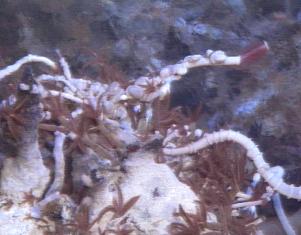 The water temperature near the vents can range from 300 degrees C at
the opening of the vent to only 1.5 degrees C 10-20 ft away. Animals
that live in this small oasis of life have made many adaptations to exist.
The unusual
animals found in this hostile habitat have only begun to be understood
over the last few years. Camera images and video from ROV (Remotely Operated
Vehicle) dives on the Juan de Fuca Ridge aid scientists in understanding
life near the hydrothermal vents on the seafloor. All animals in the vent
community depend on bacteria that feed
on hydrothermal chemicals from the vents. These bacteria are the foundation
of the ecosystem in this unusual habitat. The research vessel Thompson
will continue the viewing and study of the vents' habitat. The Thompson
joined us today here at the Axial Volcano.
The water temperature near the vents can range from 300 degrees C at
the opening of the vent to only 1.5 degrees C 10-20 ft away. Animals
that live in this small oasis of life have made many adaptations to exist.
The unusual
animals found in this hostile habitat have only begun to be understood
over the last few years. Camera images and video from ROV (Remotely Operated
Vehicle) dives on the Juan de Fuca Ridge aid scientists in understanding
life near the hydrothermal vents on the seafloor. All animals in the vent
community depend on bacteria that feed
on hydrothermal chemicals from the vents. These bacteria are the foundation
of the ecosystem in this unusual habitat. The research vessel Thompson
will continue the viewing and study of the vents' habitat. The Thompson
joined us today here at the Axial Volcano.
Join us tomorrow for the deployment of six new moorings. It will prove to be an exciting day on the Wecoma.
Fair seas,
Ms Deck.
June 21
Day 6, Monday 6/21/99
On the stern of the Wecoma is a large A-frame and winch for use on deployment of heavy scientific equipment. Dr Richard Feely, an oceanographer from NOAA/PMEL, gave me operating instructions on the use of the winch: how to pay out the wire; what to say to the crew and bridge while serving as the operator. Our mission was to set up the rosette with MAPR (Miniature Autonomous Plume Recorders) strapped to the base of the frame. This cast will be the first time this technique will be tried. The MAPR's are self-contained instruments that record data from temperature, pressure and nephelometer sensors.
Using the dry-lab's computer, data collected from this cast will be saved on computer disk. Sharon Walker, NOAA oceanographer, will be using the information to detect hydrothermal temperature and optical anomalies. These samples and records give the scientists a clearer picture of the plume in the water column. It is only in the past few cruises to the Axial Volcano site that these detailed records have been kept. Our knowledge of hydrothermal vents and plumes is growing at a rapid rate through the work of the scientists.
The weather has been constant over the day. High in the mid 50's, winds 15 knots with seas of 4-5ft.
A highlight of the afternoon was spotting 2 Sei whales off the starboard side of our vessel. I was able to watch them move across the horizon for almost 15 minutes. A field guide was helpful in identifying this mammal. Watching its blow and measuring the distance to its dorsal fin, along with size and shape helped the identification process.
I continue to observe how well this ship functions 24 hours a day. Amazing.
Come aboard tomorrow for more information on the EOI Program and it's scientists.
Fair seas,
Ms. Deck
June 20
Day 5, Sunday 6/20/99
This morning the lab was active with the completion of a "Tow-Yo". This one crossed over the caldera, or cone of the Axial Volcano at a 90 degree angle from the first. This method allows the scientists to have a clear understanding of the spread of the plume. The map table is very colorful with the location of the ship and the trailing CTD package in contrasting colors (example: yellow, blue or green and red) clearly marking each along the cruise line. Each rising and lowering of the CTD is marked with the time and depth sounded on a log sheet. Eugene Burger, a technician from NOAA/PMEL and Brian Laubner, a junior midshipmen at the U.S. Naval Academy have been busy most of the night and early morning recording the ships trackline on the map.
With each sample taken we gain a clearer understanding of the location of the volcanic plume in the water column. My understanding of the relationship among the data collected is beginning to make more sense. This exploration can be interpreted in many ways. Each scientist aboard has individual needs for profiles and the wide variety of samples to be utilized in the labs on the scientists' return.
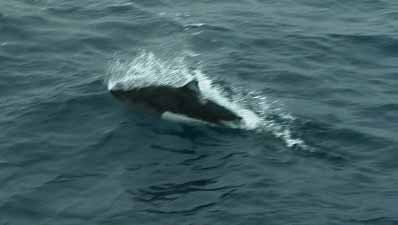 Dall's
porpoise again play along the side of our vessel in the early evening.
They feed off the stern on Saurimi (similar to herring, but pelagic open
ocean, 8"-10" long) drawn in by the ships lights. You could hear the clicking
communication and/or sonar of the dolphin when standing on the deck. It
was 1:30 am and their performance was a welcome change of pace.
Dall's
porpoise again play along the side of our vessel in the early evening.
They feed off the stern on Saurimi (similar to herring, but pelagic open
ocean, 8"-10" long) drawn in by the ships lights. You could hear the clicking
communication and/or sonar of the dolphin when standing on the deck. It
was 1:30 am and their performance was a welcome change of pace.
This is an interesting adventure! Tomorrow I am sure will bring even more....
Fair seas,
Ms. Deck
June 19
Day 4, Sat. 6/19/99
We started our day early preparing for a "tow-yo". In 1984 Dr. Ed Baker wanted a better way to collect data with a CTD in the water found near plumes of volcanoes. He coined the term "tow-yo" which means to pull a CTD rosette behind a ship in a saw-tooth or up and down motion. The performance of this type of collection has demonstrated a dynamic accuracy for scientists.
Our first tow lasted over seven hours from 4:30 am to 11:30 am. David Tennant and Sharon Walker, both oceanographers from NOAA/PMEL took turns monitoring the signal (data) highs and lows on the computer. With the push of a button a Niskin bottle is fired, which means - it closes on demand to collect a water sample of approximately 19 liters (almost 5 gallons) in each bottle. The rosette carries 20 bottles on the frame for collection. In order to deploy this scientific equipment, the ship's crew has done a wonderful job of maneuvering our vessel to minimize risk to equipment while maximizing sampling efficiency. They have done a wonderful job.
After the Niskin bottles are carried into the ship's wet lab, water is taken by many different scientists and technicians to begin the collection of data needed for their particular research interest. Rachel Shackelford and Don McGee from U. of Hawaii are interested in the bacteria found in the water sample of the subfloor habitat near the hydrothermal vent and the caldera of the Axial Volcano. They freeze their samples and will return to Hawaii with months of study and research to follow. The information gleaned will help us to better understand the food-chain established in this hydrothermal habitat.
During our tow-yo I joined the bridge just in time to spot five Orcas (Killer whales). The pod had one large whale with a dorsal fin of over five feet. I could see a smaller dorsal fin that looked like a baby or very young whale. It was exciting to see the whales in the wild.
The weather continues to be pleasant. High of 53 degrees today with a 5 ft. swell. The wind speed is 15 knots.
I am beginning to get my sea-legs and hope that tomorrow brings another exciting and interesting day aboard the Wecoma.
Check in tomorrow to see what we are up to ....
Fair seas,
Ms. Deck
June 18
Day 3 Friday 6/18/99
We were successful - all 9 moorings placed last year, we retrieved in record time!
The moorings had a variety of instruments attached to each line. Miniature Temperature Recorders (MTR) on each line with other lines having Nephelometer (Light Scanning Sensor or LSS) which sends light out and then measure the light reflected from particles. These data tell the scientists the number of particles in the tested water sample. Over the year of collection the LSS gives a data record of the particles that are in the hydrothermal plume or nearby. It is amazing we can read and compare this information - computers are a tremendous advantage for science today.
Current meters were attached to three of the moorings retrieved. They will tell us how fast and in what direction the water moves in the vicinity of the Axial Volcano. The data will be added to the accumulated surveys to be studied.
The weather today has been comfortable - about 56 degrees. Swell height is 3-4 ft. with winds of 15 knots.
We spotted whale blows off the starboard side (right) mid-day. These are most likely Blue Whales judg ing from the height of the blow. In addition to this we saw three Albatross (sea bird) circling the ship at various times during the afternoon. Our first ship sighting after three day's was a container ship that passed off our bow.
It was a busy day on the deck bringing on all the moorings deployed last year. It involved everyone's support and help. Seeing scientists as well as crew members working together builds camaraderie for a successful cruise here on the Juan de Fuca Ridge.
Tomorrow we will be putting out a "tow-yo". Join us to see what this is ... - it will be interesting!
Fair seas,
Ms Deck
June 17
Report #2
Day 2, Thursday 6/17/99
After a full day of cruising at 12 knots we reached the Axial Volcano (9pm). The crew and scientists moved into action. We deployed a carousel for sea-surface sampling.
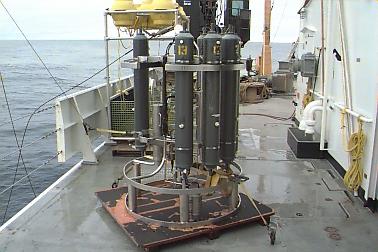 The Conductivity Temperature Depth recorder (CTD) is an
oceanographic sampling instrument with electronic sensors to continuosly
measure salinity, temperature and depth. The rosette contains Niskin bottles
that are large PVC plastic cylinders with spring loaded caps that close
at both ends. As the stainless steel frame rosette is lowered, the end
caps are open and water can pass through. Sharon Walker manned the control
panel that triggered each bottle to close at the desired depth and take
a sample. These bottles were then returned to the surface and water samples
were removed for analysis.
The Conductivity Temperature Depth recorder (CTD) is an
oceanographic sampling instrument with electronic sensors to continuosly
measure salinity, temperature and depth. The rosette contains Niskin bottles
that are large PVC plastic cylinders with spring loaded caps that close
at both ends. As the stainless steel frame rosette is lowered, the end
caps are open and water can pass through. Sharon Walker manned the control
panel that triggered each bottle to close at the desired depth and take
a sample. These bottles were then returned to the surface and water samples
were removed for analysis.
Everyone was anxious to receive seawater samples from the plume region. The collection continues through the night. Tomorrow we will be retrieving instruments that have been suspended from the seafloor for a year. Check back tomorrow to find out if we are able to recover these instruments...
Fair seas,
Ms. Deck
June 16
Day 1, Wed. 06/16/99
Come join the scientists aboard the Wecoma for a cruise to the New Millenium Observatory (NEMO) investigation of hydrothermal activity at Axial Volcano, Juan de Fuca Ridge. My name is Dena Deck and I am a fourth grade teacher from Stephen Foster Elementary School located in Lakewood, Southern California (Bellflower USD). I am a participant of the Teacher at Sea program through NOAA.
My participation on the vessel Wecoma, operated by Oregon State University, began with my arrival on Tuesday June 15. The crew and Chief Scientist, Dr. Ed Baker, were loading equipment for a variety of physical and chemical oceanographic studies.
We were away from the dock, in Seattle, at 11:00 am on Wed. morning, with scientists busily placing, taping, adjusting, strapping down (you name it!) and attaching computers and scientific equipment in the ship's lab to support the collection of data for this investigation. Everyone is enthusiastic about our cruise itinerary. Dr. Baker, Chief Scientist NOAA/PMEL and oceanographers from NOAA/PMEL and the University of Hawaii will provide answers to our many questions.
Through the porthole I can see the swell height is about 6 - 7 ft. Today's weather is comfortable with a light covering of clouds and an air temperature of 54 degrees. Our estimated arrival time at the Axial Volcano on the Juan de Fuca Ridge is at 21:00 (9 pm). Check your map, the location is 46 degrees North, 130 degrees West.
After we arrive at Axial Volcano, we will begin operations to sample the water and collect instruments on the seafloor that will tell us what's been happening here for the last year.
Check back daily and see how we are doing with this exciting investigation!
Fair seas,
Ms. Deck
(Hello to Room 33!)
For more information:
Credits/Contacts
oar.pmel.vents.webmaster@noaa.gov